Pakistan is home to a variety of birds, ranging from small sparrows to large eagles. Many of these birds are unique to the region, while others are found throughout the world.
From soaring eagles to chirping sparrows, the skies of Pakistan are a sight to behold. These birds play an important role in the local ecosystem, providing food for other animals and helping to pollinate plants.
In this article, we’ll explore some of the most interesting birds of Pakistan and learn about their habitats and behaviors.
1. Finches
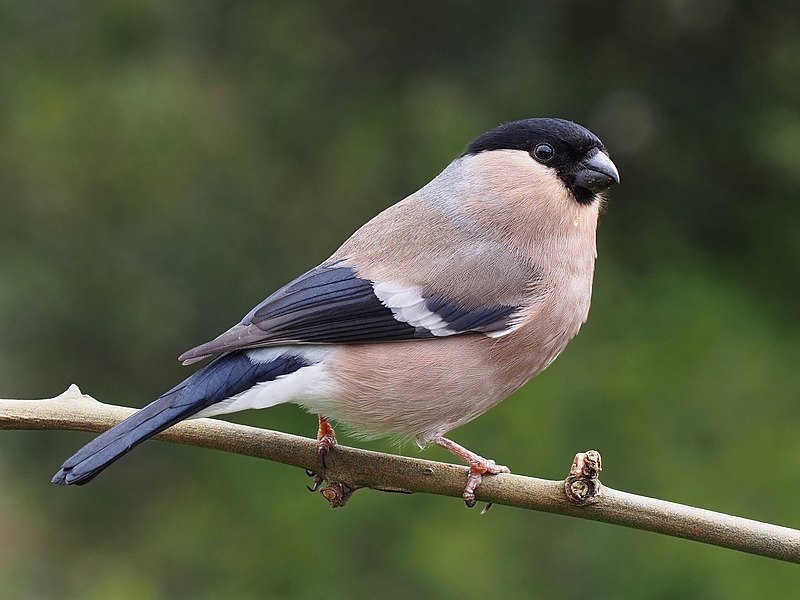
Finches are a diverse group of passerine birds found around the world, excluding Australia and polar regions. They vary in size from small to medium-sized, with stout conical bills adapted for eating seeds and nuts.
Many species have brightly coloured plumage; this helps them stand out against their natural habitats which can range from deserts to forests.
Finches occupy these areas all year round without migrating elsewhere – making them particularly well suited for local environments.
As part of the Fringillidae family they possess unique characteristics that make them popular amongst birdwatchers everywhere.
Scientific classification:
| Kingdom | Animalia |
| Phylum | Chordata |
| Class | Aves |
| Order | Passeriformes |
| Superfamily | Passeroidea |
| Family | Fringillidae Leach, 1820 |
Also Featured In: Birds for Your Home Garden, Most Common Winter Birds
2. Houbara Bustard
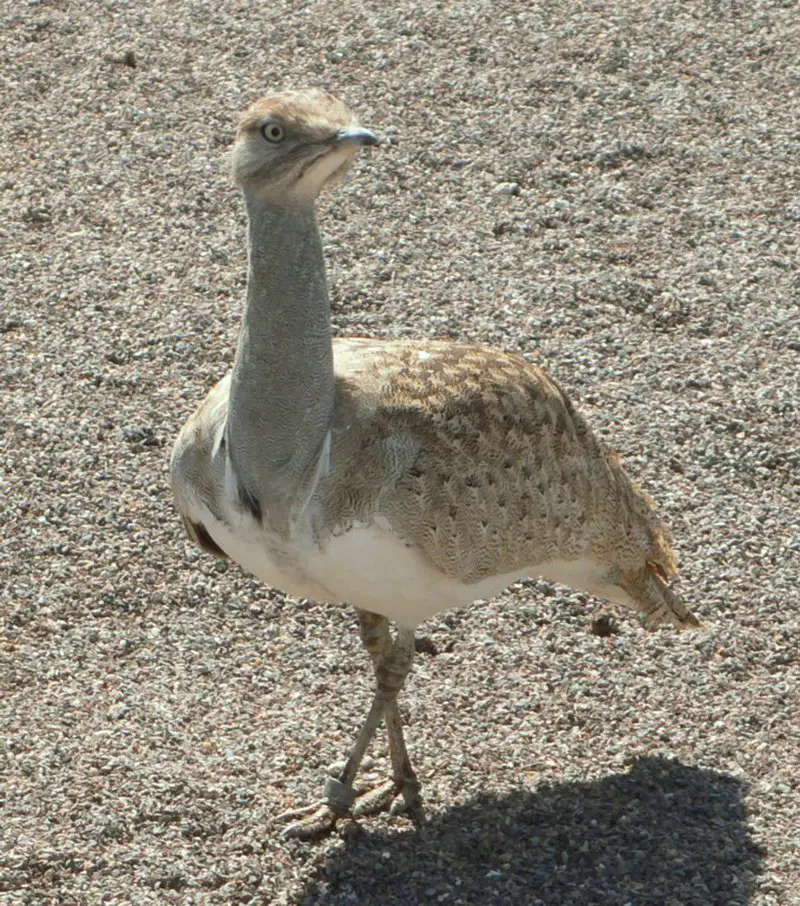
The Houbara Bustard is a small bird native to North Africa. It has dull brown feathers with black markings on the wings, and a grey crown of feathers atop its head.
This species inhabits arid habitats, making it particularly vulnerable in this environment due to lack of resources available.
The global population is listed as Vulnerable by IUCN Red List and there is also a population in the Canary Islands which has been assessed as Near Threatened.
Conservation efforts have been put into place but more needs to be done if we are going to protect these birds from endangerment or extinction.
We must ensure that their habitat remains protected so they can thrive in safety for generations to come.
Scientific classification:
| Kingdom | Animalia |
| Phylum | Chordata |
| Class | Aves |
| Order | Otidiformes |
| Family | Otididae |
| Genus | Chlamydotis |
| Species | C. undulata |
Also Featured In: Birds Live in Tunisia, Birds of Lanzarote
3. Phasianidae
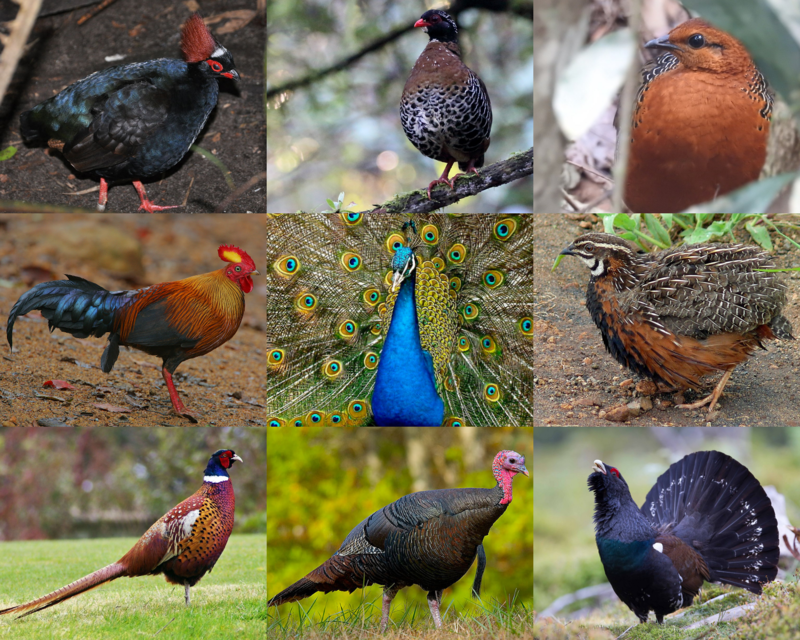
The Phasianidae family of birds is one that contains many popular gamebirds, with a total of 185 species divided across 54 genera.
These heavy ground-living birds include pheasants, partridges, junglefowl, chickens, and turkeys among others like Old World quail and peafowl.
This large family was formerly split into two subfamilies known as the Phasianinae and Perdicinae but this classification has since been changed to reflect more current scientific findings on them.
All these different types of birds have certain things in common such as their strong legs for scratching through leaves or soil looking for food items including insects, seeds, and other vegetation which makes up most of their diet.
They also all tend to be quite colorful in order to attract mates during breeding season when males will often display vibrant feathers or do dances around females in an attempt at courtship ritual displays.
The majority are monogamous creatures too although some may form short-term pair bonds before going off alone again once mating has taken place – either way.
There tends to be very little parental care given by adults after eggs have hatched so chicks need to fend for themselves right away.
Scientific classification:
| Kingdom | Animalia |
| Phylum | Chordata |
| Class | Aves |
| Order | Galliformes |
| Superfamily | Phasianoidea |
| Family | Phasianidae Horsfield, 1821 |
4. Western Tragopan
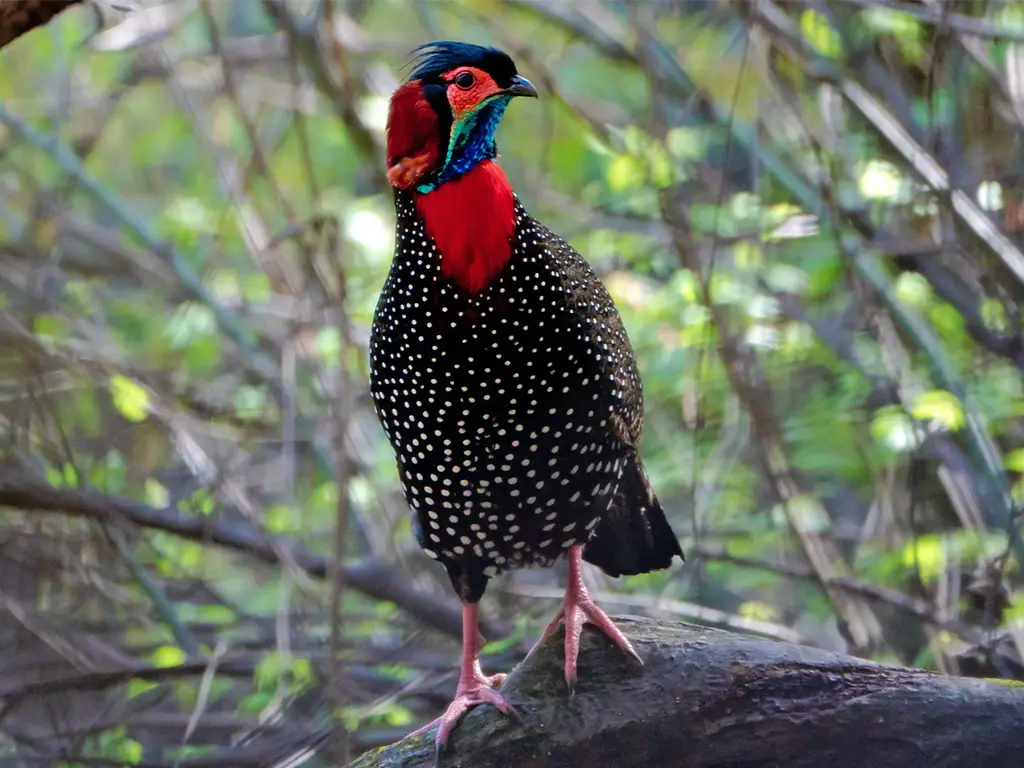
The Western Tragopan is an iconic bird of the Himalayas, boasting a dazzling array of radiant feathers. The male has striking black and grey plumage with white spots all over its body.
It’s highly endangered species that is globally threatened due to habitat loss in its range along the Himalayan mountain chain from northeastern Khyber Pakhtunkhwa province in Pakistan to Uttarakhand state within India.
Its survival relies on protecting remaining areas where it can thrive undisturbed by humans as well as reintroducing captive-bred populations into suitable habitats for long term sustainability.
Without conservation efforts, this unique creature may disappear forever from our world making us poorer for not having had the chance to admire such beauty ever again
Scientific classification:
| Kingdom | Animalia |
| Phylum | Chordata |
| Class | Aves |
| Order | Galliformes |
| Family | Phasianidae |
| Genus | Tragopan |
| Species | T. melanocephalus |
Also Featured In: Birds that Live in Uttarakhand,
5. Sind Woodpecker
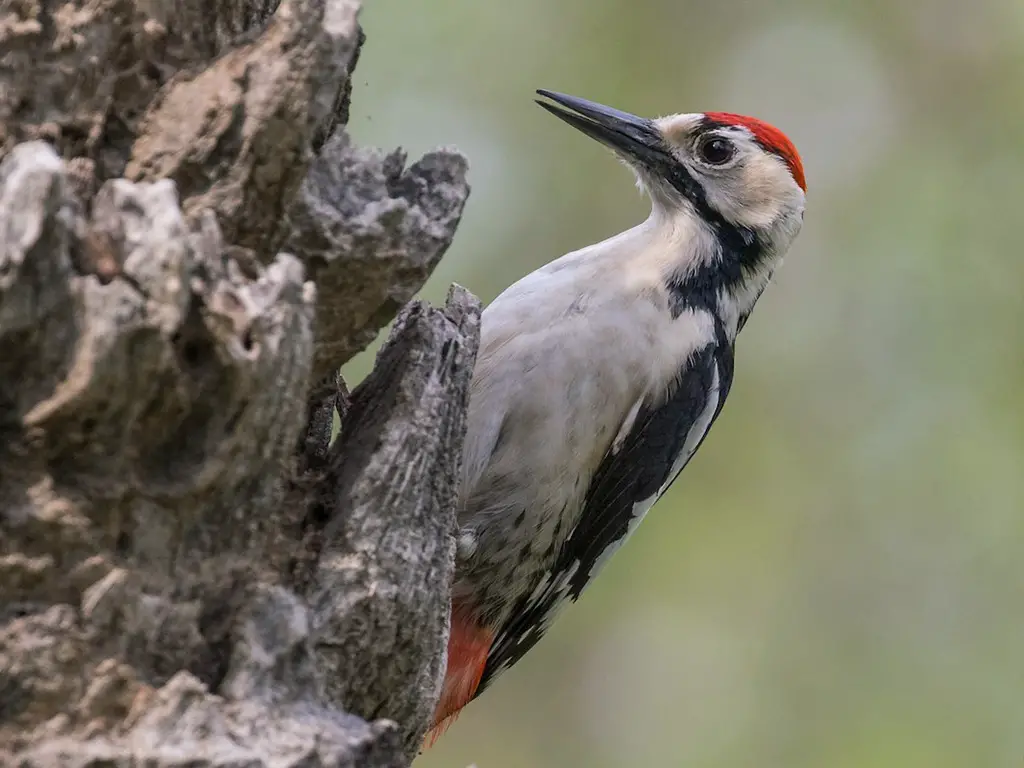
Sind woodpecker is a species of bird belonging to the family Picidae. It is natively found in Pakistan, India and southern Iran. It has white shoulder patches and black feathers with bars on them that distinguishes.
It from other birds of its kind like Syrian woodpeckers which are larger in size having thick mustache along with excessive white feathers on their back and bigger beak.
Sind Woodpeckers prefer forests where they feed mainly upon insects, larvae and grubs by hammering into tree barks using their large beaks for hunting purposes.
They also have unique calls to attract mates as well as mark territories during breeding season making them an interesting sight among forest dwellers all around the world.
Scientific classification:
| Kingdom | Animalia |
| Phylum | Chordata |
| Class | Aves |
| Order | Piciformes |
| Family | Picidae |
| Genus | Dendrocopos |
| Species | D. assimilis |
6. Siberian Crane
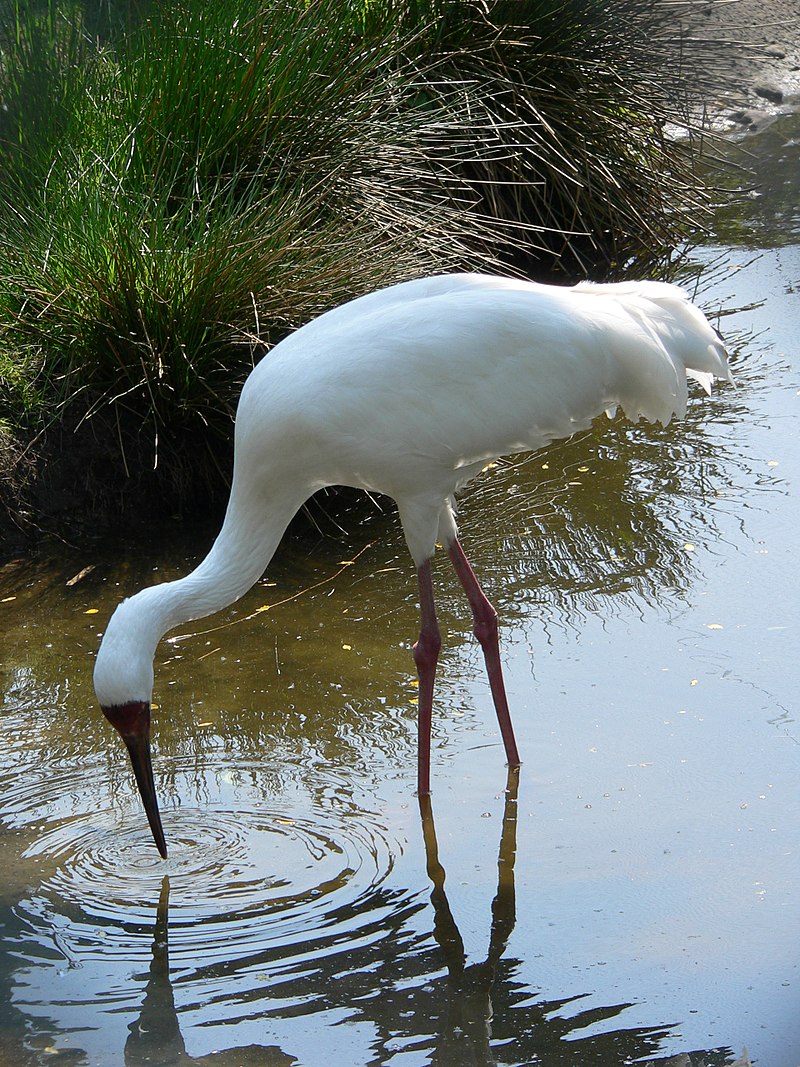
The Siberian crane is a majestic white bird of the family Gruidae. It has two distinct breeding populations in Russia, one in eastern and other in western Arctic tundra region.
In flight it can be identified by its black primary feathers which stand out against its otherwise snowy white body.
These graceful birds have an average wingspan of 2 metres and are known to migrate from their wintering grounds at India’s Keoladeo National Park to Siberia during summer months for breeding purposes.
They feed mainly on plants, grains, mollusks as well as small amphibians or fish when available near wetlands.
Due to loss of habitat and hunting these elegant cranes are listed as critically endangered species with less than 3200 individuals remaining worldwide today making them highly vulnerable to extinction if necessary conservation measures aren’t taken soon enough.
Scientific classification:
| Kingdom | Animalia |
| Phylum | Chordata |
| Class | Aves |
| Order | Gruiformes |
| Family | Gruidae |
| Genus | Leucogeranus Bonaparte, 1855 |
| Species | L. leucogeranus |
Also Featured In: Hong Kong Birds You Need to See, Birds of Taiga
7. Himalayan Monal
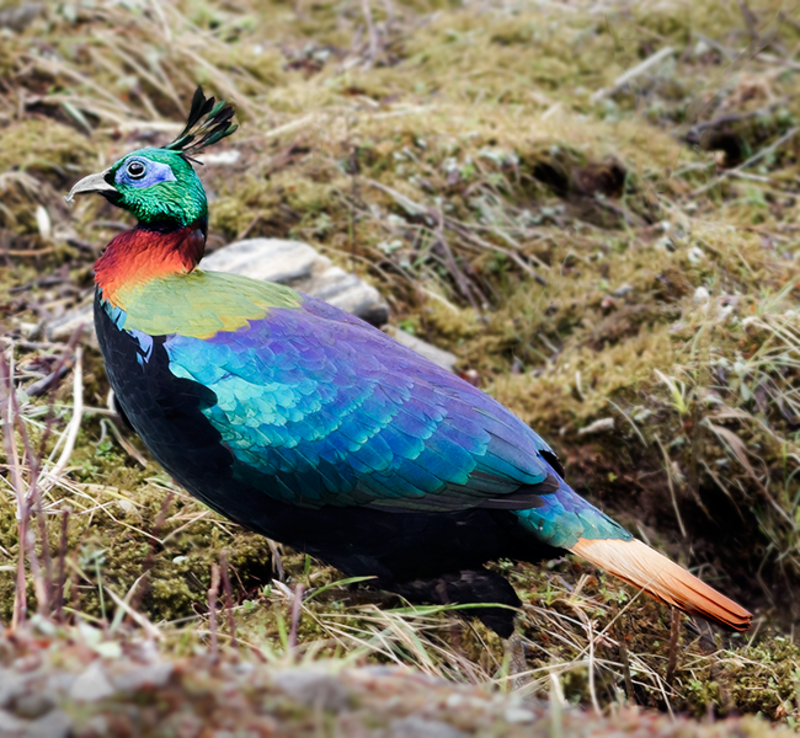
The Himalayan monal (Lophophorus impejanus) is a beautiful species of pheasant native to the forests and shrublands of the Himalayas. It can be found at elevations ranging from 2,100-4,500 meters.
This magnificent creature has been listed as Least Concern on IUCN’s Red List due to its wide distribution range and stable population size.
In Nepal it is known as Danphe or Danfe, which also happens to be their national bird.
Uttarakhand in India recognizes this species as their state bird too. The colorful feathers boast hues of green, blue and bronze that make them quite captivating to watch out for.
Scientific classification:
| Kingdom | Animalia |
| Phylum | Chordata |
| Class | Aves |
| Order | Galliformes |
| Family | Phasianidae |
| Genus | Lophophorus |
| Species | L. impejanus |
8. Greater Hoopoe-Lark
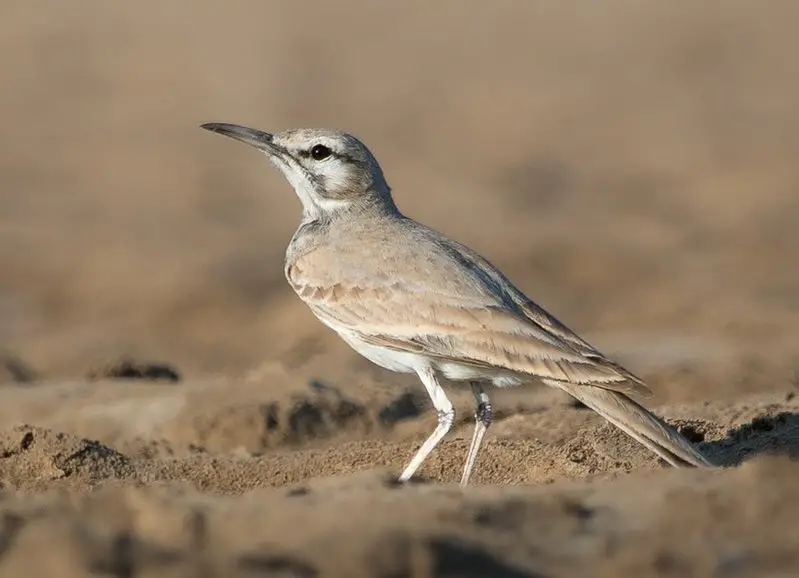
The Greater hoopoe-lark is a passerine bird that can be found in arid and semi-desert regions of Africa, the Arabian peninsula, Syria, Afghanistan, Pakistan and India.
It was formerly known as the bifasciated lark or large desert lark. These birds have adapted to living in harsh climates with little water sources by having sparse feathers which helps them retain body heat during cold nights.
They are also able to consume insects from dry soils for sustenance when food resources become scarce.
During mating season they display their distinctive markings by singing from atop bushes or trees while flapping their wings vigorously before swooping down towards potential mates on the ground below.
The greater hoopoe-larks diet mainly consists of seeds and small invertebrates like beetles, spiders and larvae making them an important part of maintaining local insect populations too.
Scientific classification:
| Kingdom | Animalia |
| Phylum | Chordata |
| Class | Aves |
| Order | Passeriformes |
| Family | Alaudidae |
| Genus | Alaemon |
| Species | A. alaudipes |
Also Featured In: Italian Birds You Should Know,
9. Indian White-Eye
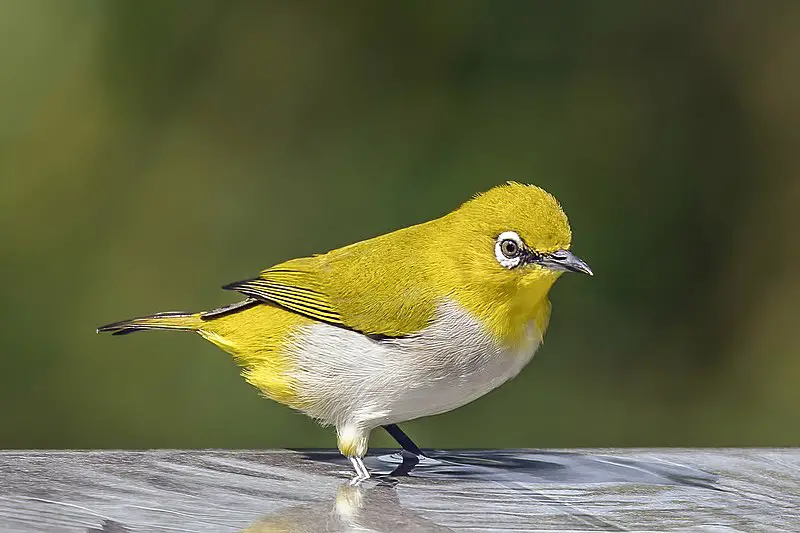
The Indian white-eye is a small passerine bird belonging to the white-eye family. It is found in open woodland of the Indian subcontinent, where it breeds and resides throughout the year.
These birds forage together in groups, feeding on nectar and insects. They are easily recognizable due to their bright yellowish upperparts and distinctive white eye rings – an identifying feature exclusive to them.
The range of these birds previously extended eastward but has since been reduced significantly over time due to habitat loss.
Scientific classification:
| Kingdom | Animalia |
| Phylum | Chordata |
| Class | Aves |
| Order | Passeriformes |
| Family | Zosteropidae |
| Genus | Zosterops |
| Species | Z. palpebrosus |
Also Featured In: Common Birds in Bangalore,
10. Chukar
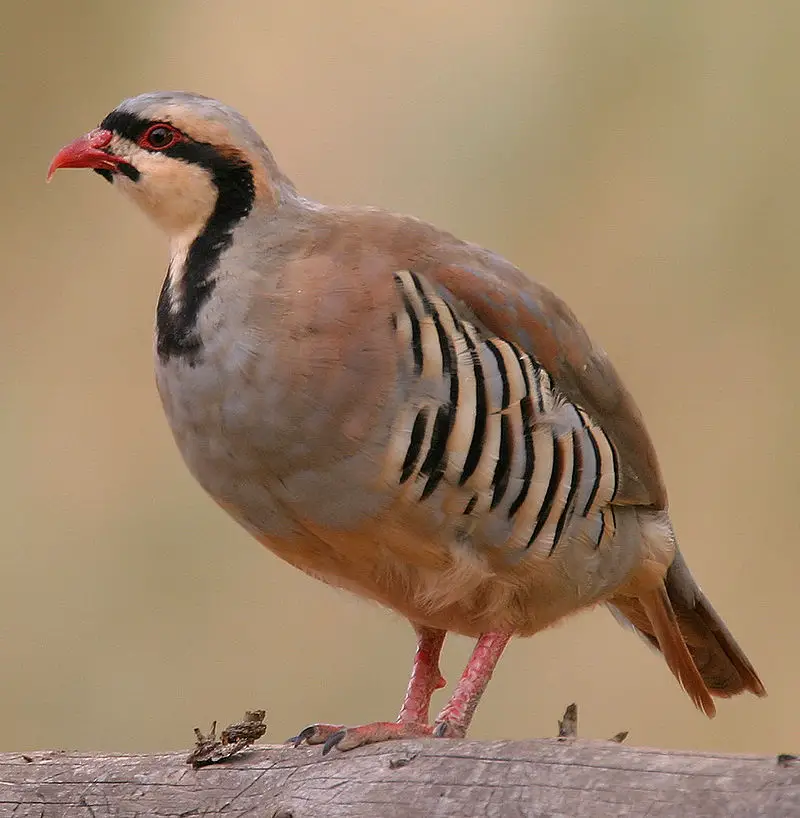
Chukar is a Palearctic upland gamebird belonging to the pheasant family. It has distinctive black and white bars on its flanks, as well as brown upperparts and buff underparts.
Its head is grey with an off-white face, throat and crest which turns chestnut in males during breeding season.
The Chukar typically lives in dry regions like open terrain or semi arid hillsides where it feeds mainly on seeds and invertebrates.
During winter months they tend to inhabit more wooded areas looking for shelter from harsh winds or snow storms.
They are social birds living in groups of up to 20 individuals but will pair off when mating season arrives.
Scientific classification:
| Kingdom | Animalia |
| Phylum | Chordata |
| Class | Aves |
| Order | Galliformes |
| Family | Phasianidae |
| Genus | Alectoris |
| Species | A. chukar |
Also Featured In: Birds That Live in Iraq, Lebanon Birds Live in Semi-Desert Areas
11. Bank Myna
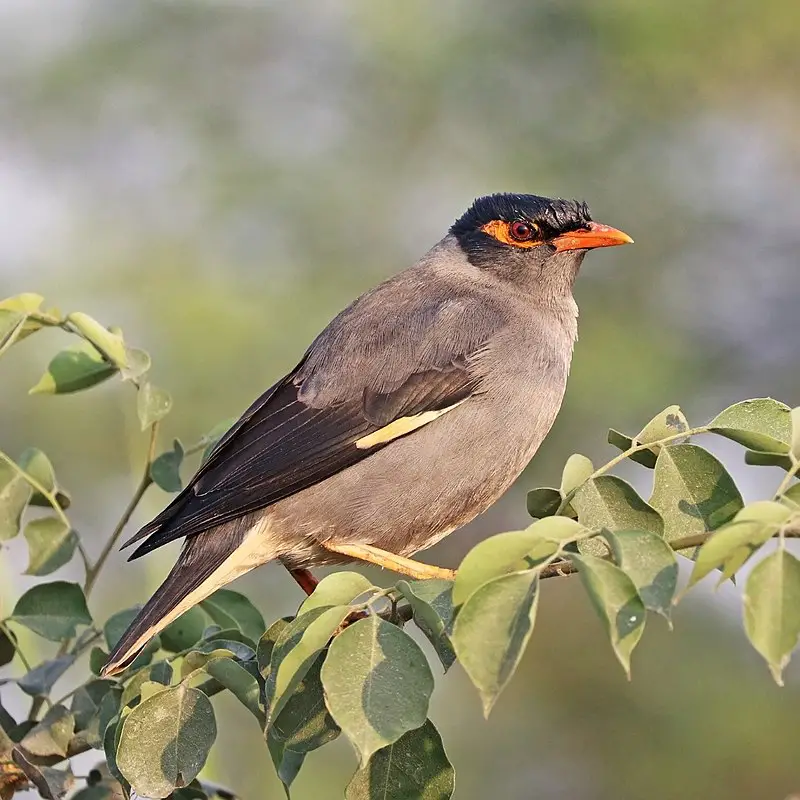
The Bank Myna is a small bird belonging to the myna family, found in the northern parts of South Asia. It has greyish brown plumage with brick-red skin behind its eyes and white feathers on its abdomen.
The most distinctive feature that sets it apart from other mynas is its tuft of feathers at the back of its head which gives it an elegant look. It usually resides in flocks, feeding mostly on fruits, grains and insects.
They also have a loud call which they use for communication among themselves as well as to ward off predators or rivals within their area.
These birds are very social creatures and can often be seen perched atop branches or flying around together in groups looking for food sources like grasslands & agricultural fields etc., making them quite popular amongst farmers who rely heavily upon these birds’ natural pest control abilities.
Scientific classification:
| Kingdom | Animalia |
| Phylum | Chordata |
| Class | Aves |
| Order | Passeriformes |
| Family | Sturnidae |
| Genus | Acridotheres |
| Species | A. ginginianus |
Also Featured In: Birds of Islamabad,
12. Indian Vulture
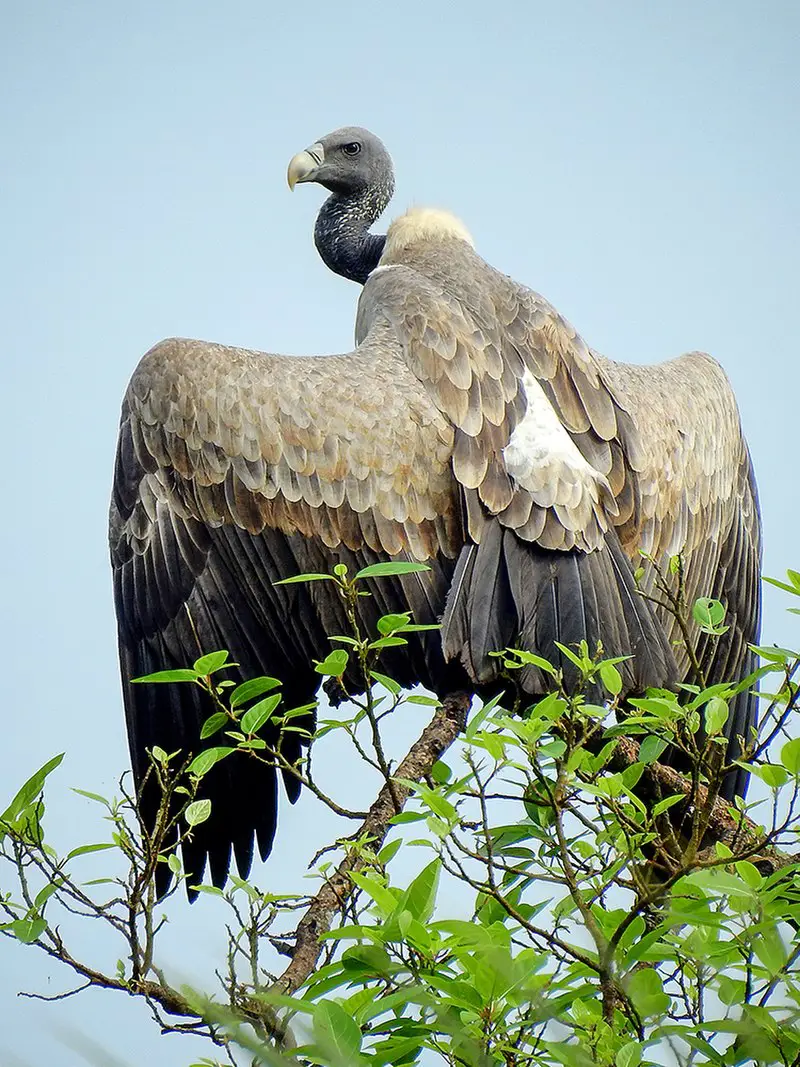
The Indian vulture is a large bird of prey found in India, Pakistan and Nepal. It has an old world appearance with its striking black plumage and white ruff around the neck.
Unfortunately it is Critically Endangered since 2002 due to drastic decline in population caused by diclofenac poisoning leading to kidney failure among these birds.
The species mainly nests on hilly crags across central and peninsular India making them vulnerable as they are unable to migrate away from their breeding grounds during harsh weather conditions or food scarcity.
In addition, their close relative Slender-billed Vultures (Gyps tenuirostris) also faces similar threats owing to same reasons further decreasing this species’ numbers even more drastically over time unless conservation efforts are taken up soon.
Scientific classification:
| Kingdom | Animalia |
| Phylum | Chordata |
| Class | Aves |
| Order | Accipitriformes |
| Family | Accipitridae |
| Genus | Gyps |
| Species | G. indicus |
Also Featured In: Birds that Live in Rajasthan, Most Common Madhya Pradesh Birds
13. Great Indian Bustard
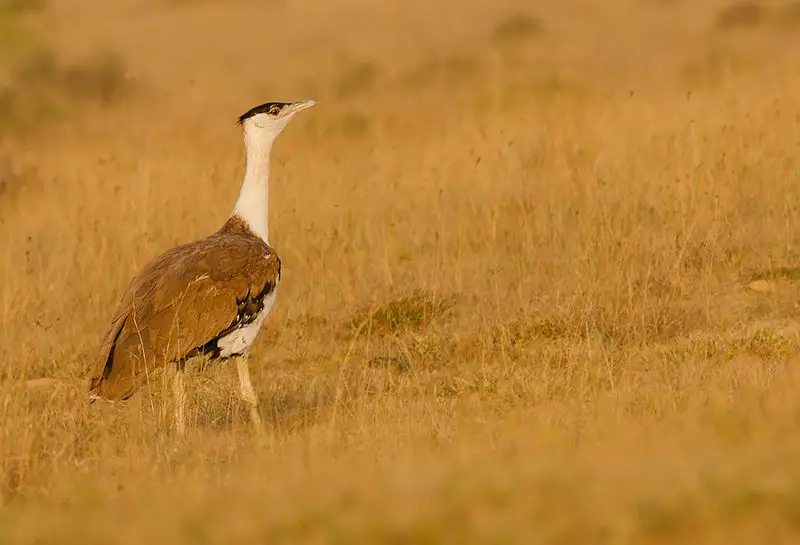
The Great Indian Bustard is a majestic bird found on the Indian subcontinent. It has an ostrich-like appearance, with its horizontal body and long bare legs making it one of the heaviest flying birds in the world.
Sadly, due to intense hunting and habitat loss their numbers have dwindled drastically since 2018 from 1,250 individuals to just 150.
This beautiful species needs our help as they are now critically endangered. Conservation efforts must be taken up urgently for them if we wish for future generations to experience these wonderful creatures in all their glory.
Scientific classification:
| Kingdom | Animalia |
| Phylum | Chordata |
| Class | Aves |
| Order | Otidiformes |
| Family | Otididae |
| Genus | Ardeotis |
| Species | A. nigriceps |
14. Red-Billed Tropicbird
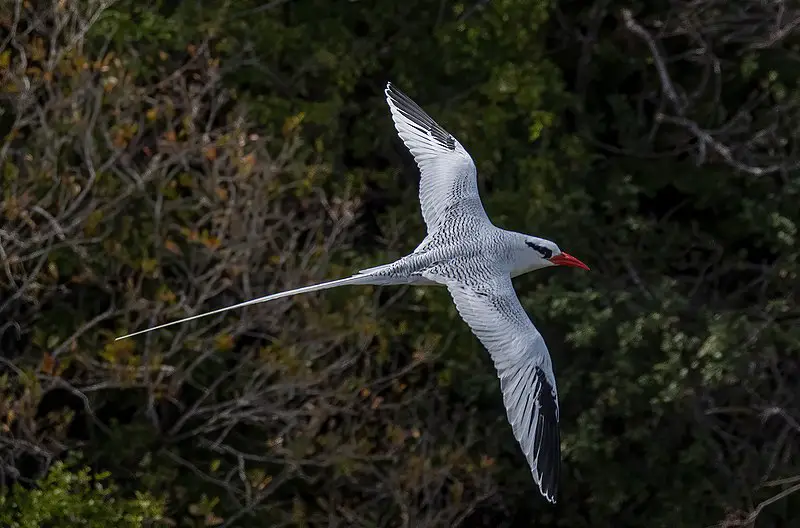
The Red-billed Tropicbird is a beautiful seabird found in tropical oceans. It has mainly white plumage, with black markings on its wings and back, along with a black mask and red bill.
These birds have distinctive long tail streamers that are twice their body length which they use to help them soar above the ocean surface while searching for food.
They primarily feed off squid, fish and crustaceans that inhabit coral reefs or deep sea areas where they can dive up to 30 meters below the water’s surface.
The Red-billed Tropicbird was once thought of as an omen of bad luck but now it serves as a reminder of how delicate our marine ecosystems are when faced with human activity such as overfishing.
Scientific classification:
| Kingdom | Animalia |
| Phylum | Chordata |
| Class | Aves |
| Order | Phaethontiformes |
| Family | Phaethontidae |
| Genus | Phaethon |
| Species | P. aethereus |
Also Featured In: Galapagos Birds You Should Know, Birds of Galápagos Islands You Need to Know
15. Indian Spot-Billed Duck
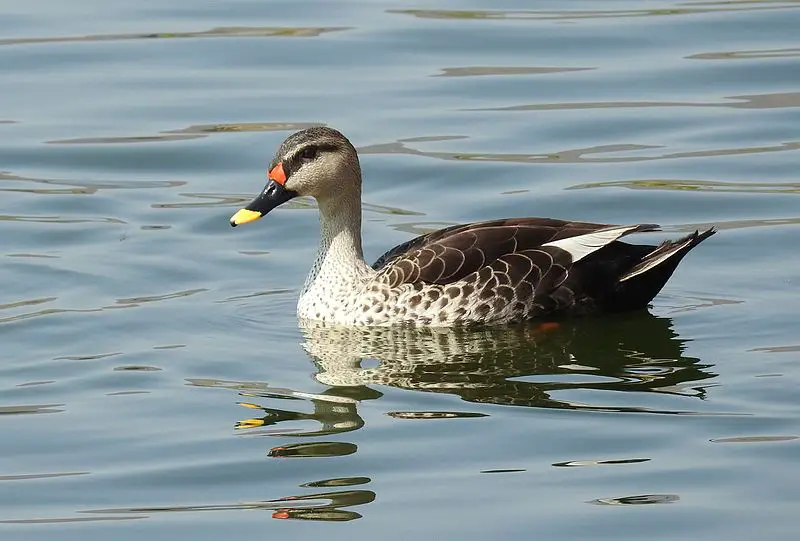
The Indian spot-billed duck is a large dabbling duck found throughout freshwater wetlands in the Indian subcontinent. It gets its name from the red spot at the base of its bill, which is only seen on mainland birds.
Distinctive white tertials form a stripe down their sides, making it easy to recognize them even when far away.
They feed mainly on aquatic vegetation and invertebrates including molluscs and insects but will also consume some grains and fruits during dry seasons or if food becomes scarce.
When not breeding they can be found in flocks with other ducks such as teals or pochards.
Breeding season varies by region but typically takes place between March–May, where pairs build nests close to water usually among reeds or grasses lining ponds, marshes, rivers etc..
The female incubates her eggs for around 24 days before hatching occurs; afterwards both parents care for their young until they fledge after 45-50 days old.
Scientific classification:
| Kingdom | Animalia |
| Phylum | Chordata |
| Class | Aves |
| Order | Anseriformes |
| Family | Anatidae |
| Genus | Anas |
| Species | A. poecilorhyncha |
Also Featured In: Gujarati Birds, Common Birds of Maharashtra
16. Indian Grey Hornbill
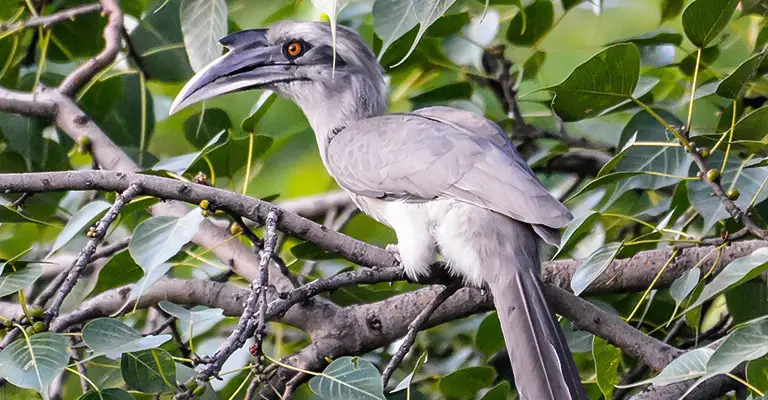
The Indian gray hornbill is a common bird found throughout the Indian subcontinent. It has grey feathers covering its body and a light grey or dull white belly.
Its distinctive feature is an iconic black or darkly-colored horn with a casque extending to the point of curvature on top of it’s head.
They are mostly arboreal, often seen in pairs, and can even be spotted in urban areas across India.
The diet consists mainly of fruit such as figs along with seeds, small reptiles and insects too.
Their loud calls help them communicate over long distances making them easily identifiable within their habitat range .
Scientific classification:
| Kingdom | Animalia |
| Phylum | Chordata |
| Class | Aves |
| Order | Bucerotiformes |
| Family | Bucerotidae |
| Genus | Ocyceros |
| Species | O. birostris |
Also Featured In: Common Birds that Live in Odisha, Delhi Birds You Need to See
17. Painted Sandgrouse
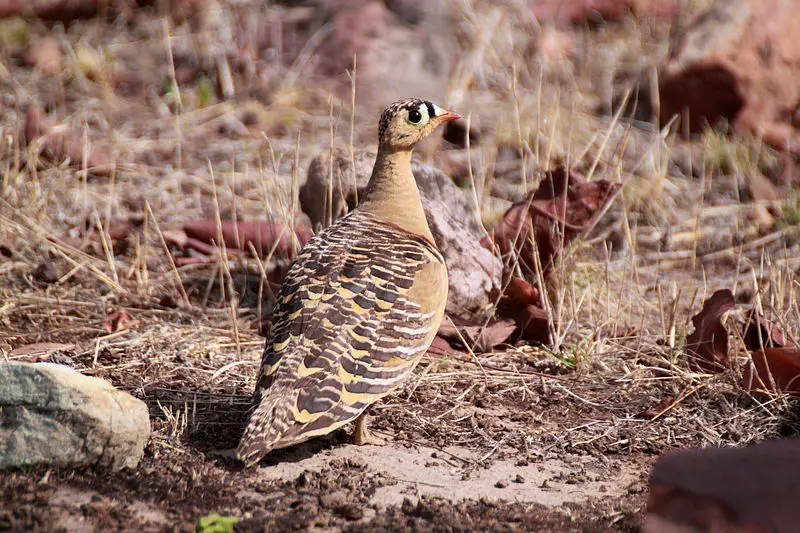
The Painted Sandgrouse is a species of bird found in Bangladesh, India and Pakistan. It belongs to the sandgrouse family and has an average size compared to other similar birds.
Johann Friedrich Gmelin was the first one who formally described it back in 1789 for Carl Linnaeus’s Systema Naturae.
The most remarkable feature about this bird is its gorgeous coloration on both males and females.
They have white patches across their wings with brownish-gray feathers covering their bodies along with some black markings around the head and neck area.
They are also quite capable fliers as they often cover long distances from water sources during dry seasons when food becomes scarce.
All these features make them truly unique among all other grouse-like birds out there.
Scientific classification:
| Kingdom | Animalia |
| Phylum | Chordata |
| Class | Aves |
| Order | Pterocliformes |
| Family | Pteroclidae |
| Genus | Pterocles |
| Species | P. indicus |
18. Indian Courser
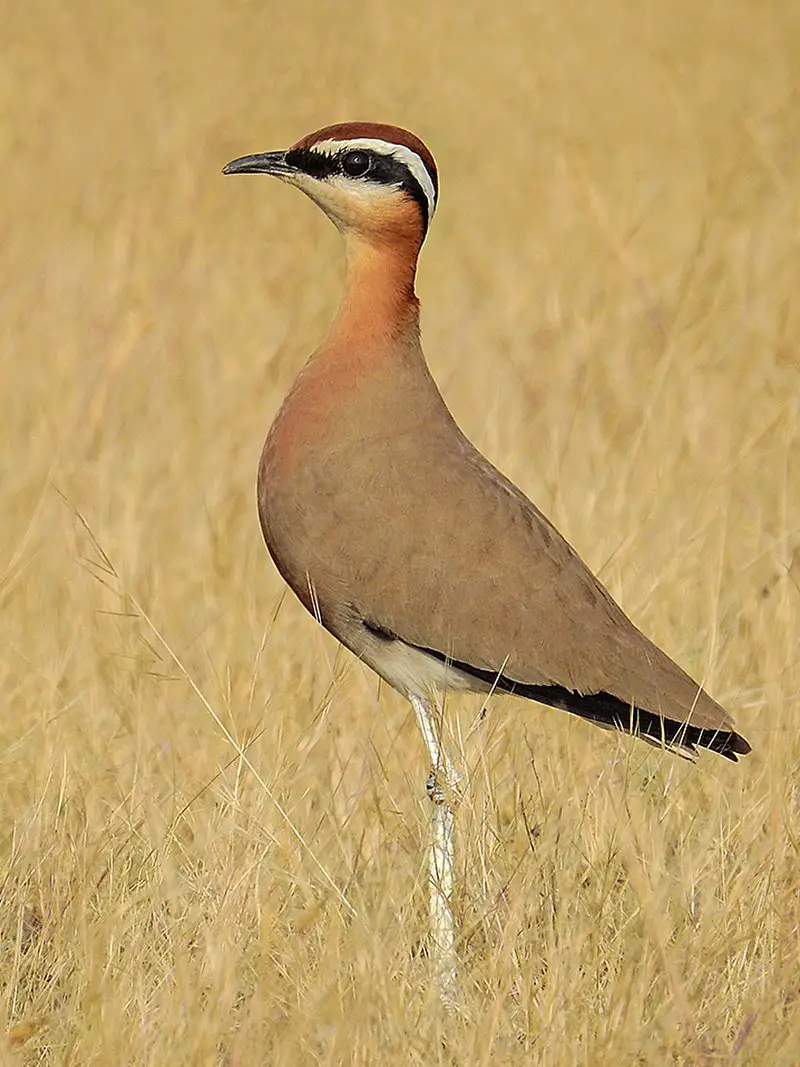
The Indian courser is a species of bird found in South Asia, mostly around the Ganges and Indus river systems. It belongs to the family of ground birds known as “coursers”.
Small groups can be seen foraging on insects amongst dry and open semi-desert areas.
The first scientific description was by Johann Friedrich Gmeli in 1789, with them being quite small but striking creatures due to their white stripes running down its back and black neck rings.
They prefer warm climates with little rainfall or snowfall; however they are still very adaptable when it comes to food sources such as grasshoppers, beetles or spiders which make up most of their diet.
Although not endangered yet, there’s concern that humans may encroach upon its natural habitat leading to population decline if left unchecked .
Scientific classification:
| Kingdom | Animalia |
| Phylum | Chordata |
| Class | Aves |
| Order | Charadriiformes |
| Family | Glareolidae |
| Genus | Cursorius |
| Species | C. coromandelicus |
Also Featured In: Common Birds of Chhattisgarh,
19. Himalayan Snowcock
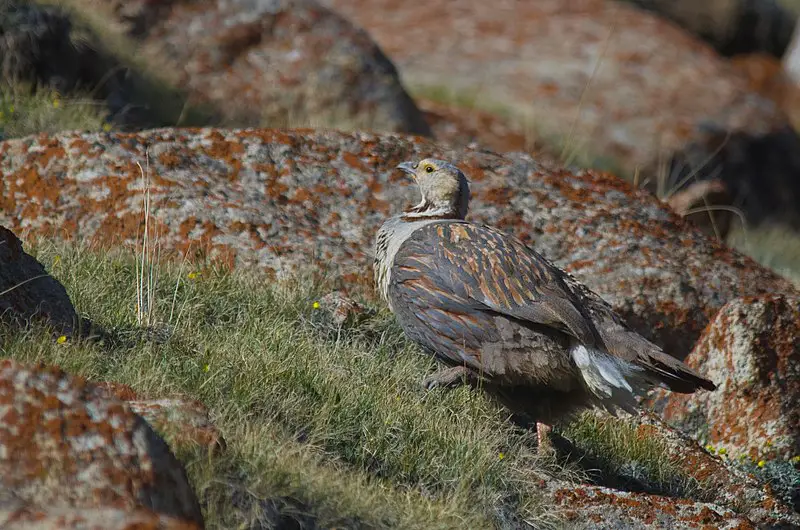
The Himalayan snowcock is a beautiful bird native to the remote, alpine regions of the Himalayas and Pamir range. They prefer rocky cliffs where they can dive into steep hill slopes for safety.
These birds are large in size compared to their closely related species, the Tibetan snowcock, with males reaching up to 25 inches long and weighing an average 2 pounds.
The plumage on these birds varies from grey-brown wings with white spotting along its backside and black barring on tail feathers; while underbelly feathers are bright rusty orange coloration.
Its diet consists primarily of plant matter such as seeds, grasses and flower buds found amongst rocks or high mountain meadows during summer months when it migrates higher up in altitude seeking cooler temperatures during hot season.
Scientific classification:
| Kingdom | Animalia |
| Phylum | Chordata |
| Class | Aves |
| Order | Galliformes |
| Family | Phasianidae |
| Genus | Tetraogallus |
| Species | T. himalayensis |
Also Featured In: Birds of Ladakh,
20. Indian Paradise Flycatcher
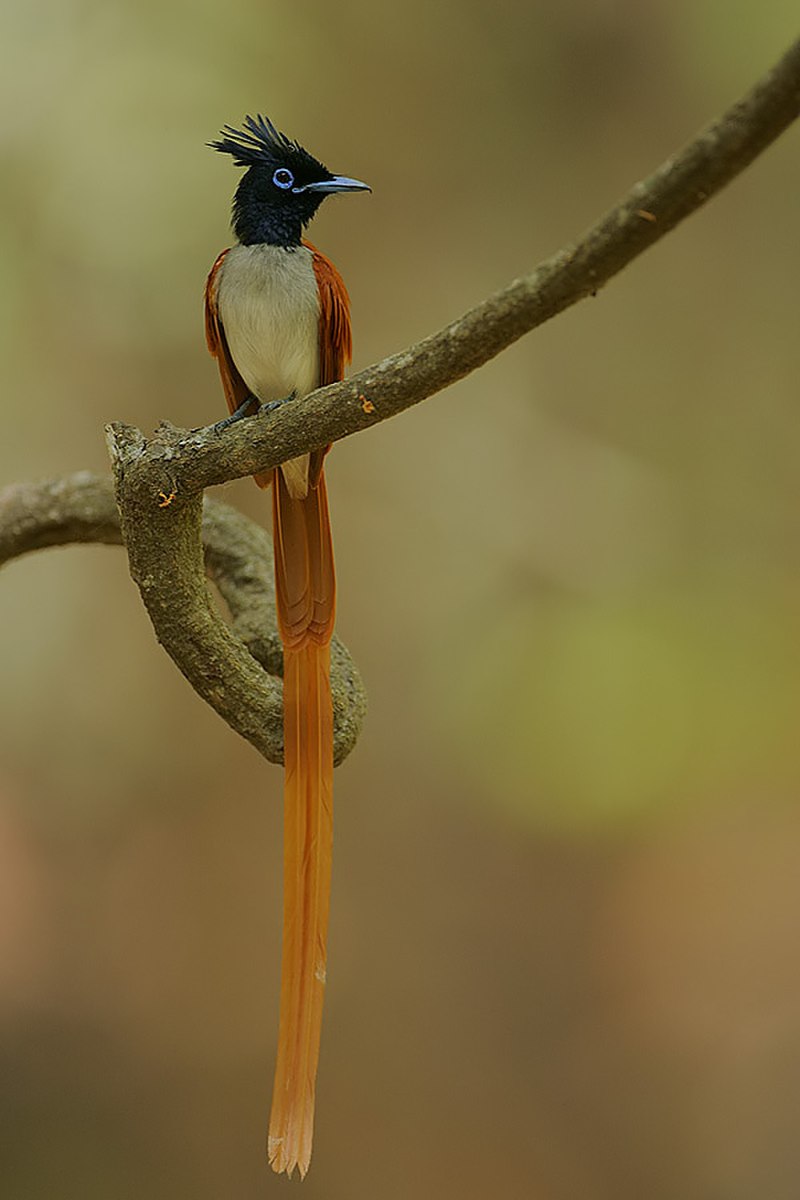
The Indian paradise flycatcher is a beautiful bird native to Asia. It has an overall black and rufous plumage, but the males have elongated central tail feathers that really stand out.
This species is considered stable globally, so it is listed as Least Concern on IUCN’s Red List of Threatened Species.
The range of this passerine extends from India in the South Asian subcontinent all the way up to Central Asia and Myanmar.
Despite its beauty, sadly these birds are also threatened by loss of habitat due to urbanization and deforestation caused by humans- we must do our best to protect them.
Scientific classification:
| Kingdom | Animalia |
| Phylum | Chordata |
| Class | Aves |
| Order | Passeriformes |
| Family | Monarchidae |
| Genus | Terpsiphone |
| Species | T. paradisi |
Also Featured In: Native Birds of Kazakhstan, Black And White Birds You Don’t Know About
21. Kalij Pheasant
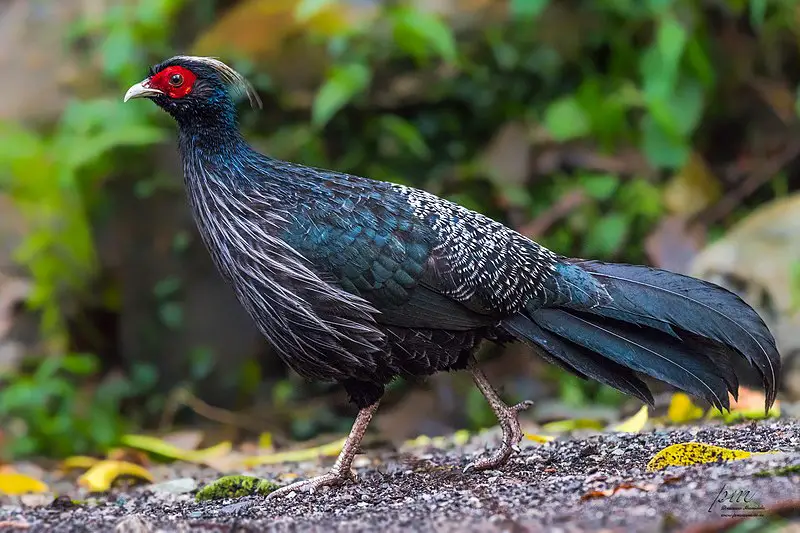
The Kalij Pheasant is a colourful bird found in forests and thickets of the Himalayan foothills, from Pakistan to western Thailand. Males have glossy bluish-black plumage with white markings on their wings, while females are overall brownish.
Both sexes feature a bare red face and grey legs that set them apart from other pheasants. They feed mainly on insects but will also eat seeds and grain when available, making them omnivores by nature.
When courting or displaying aggression towards rivals they create loud vocalisations as well as physical displays such as fluffing up feathers or fanning tails outwards.
These birds live alone during winter months but form pairs for mating season which typically occurs between March – May each year resulting in clutches of eggs being laid shortly after pairing off.
Scientific classification:
| Kingdom | Animalia |
| Phylum | Chordata |
| Class | Aves |
| Order | Galliformes |
| Family | Phasianidae |
| Genus | Lophura |
| Species | L. leucomelanos |
Also Featured In: Hawaii Big Island Birds You Should Know, Birds of Jim Corbett National Park
22. Koklass Pheasant
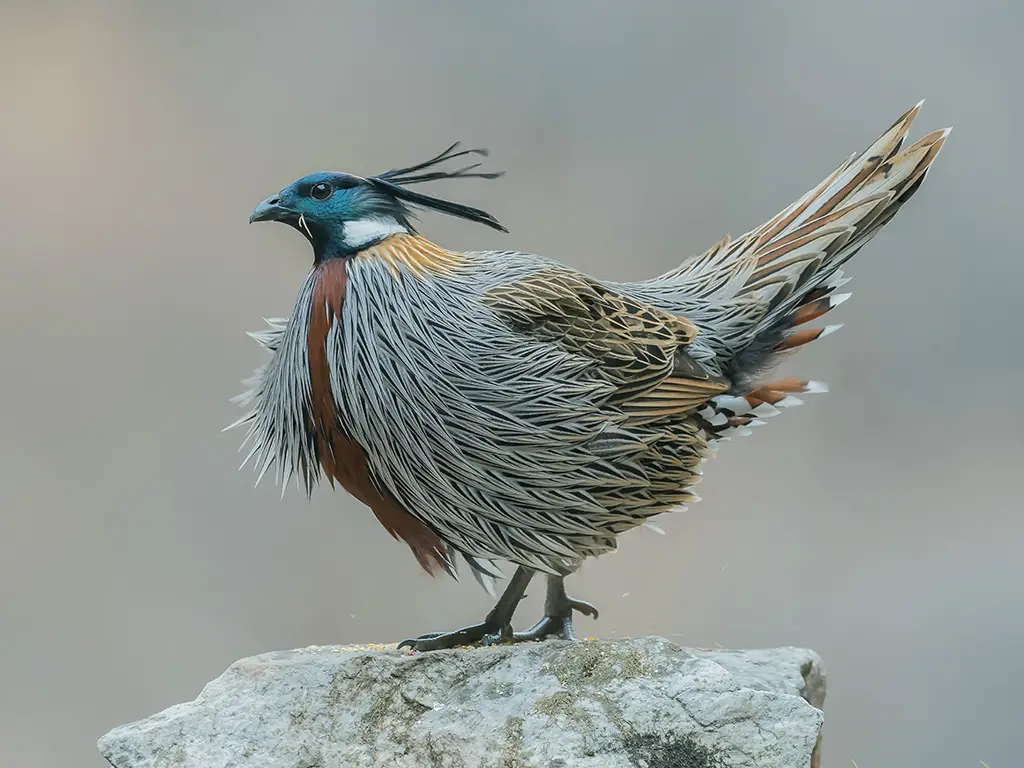
The Koklass pheasant is a unique species of gamebird, closely related to progenitive grouse from the Miocene. It has its own genus Pucrasia and can be found in parts of Asia such as India, Nepal and China.
These birds have an impressive plumage that includes shades of black, blue-grey and white.
They also possess striking fan crest feathers on their heads which are erected during territorial calls; hence why both koklass and pucrasia were derived from the bird’s distinctive sound.
Males tend to be larger than females but they share similar behaviours like eating insects or plant material off the ground while making short flights between vegetation cover when disturbed by predators.
All in all, this marvellous bird captivates people with its beauty – it truly deserves admiration.
Scientific classification:
| Kingdom | Animalia |
| Phylum | Chordata |
| Class | Aves |
| Order | Galliformes |
| Family | Phasianidae |
| Subfamily | Phasianinae |
| Genus | Pucrasia G.R. Gray, 1841 |
| Species | P. macrolopha |
23. Indian Pond Heron
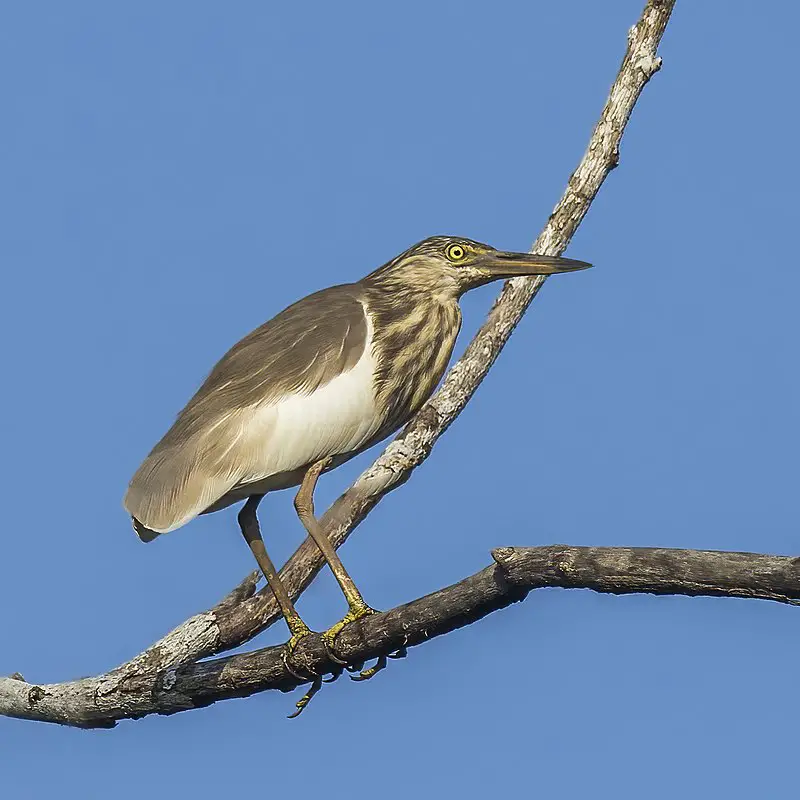
The Indian Pond Heron, also called Paddybird is a small heron found in the Old World. It breeds from southern Iran to India, Burma and Sri Lanka and can be seen near waterbodies or even around human habitations.
These birds are easily recognisable when they take off as their wings make a loud whistling sound due to its long flight feathers which are greyish-brown with white patches on them.
They feed mainly on fish but will eat other aquatic creatures such as frogs and insects too.
During breeding season they construct nests made of reeds close to water bodies where they lay 3–5 eggs at once.
The female incubates the eggs for about 19 days after which both parents share duties of feeding chicks until juveniles become independent enough to fly away.
Scientific classification:
| Kingdom | Animalia |
| Phylum | Chordata |
| Class | Aves |
| Order | Pelecaniformes |
| Family | Ardeidae |
| Genus | Ardeola |
| Species | A. grayii |
Also Featured In: Common Birds in Kerala, Birds of Karnataka
24. Indian Roller
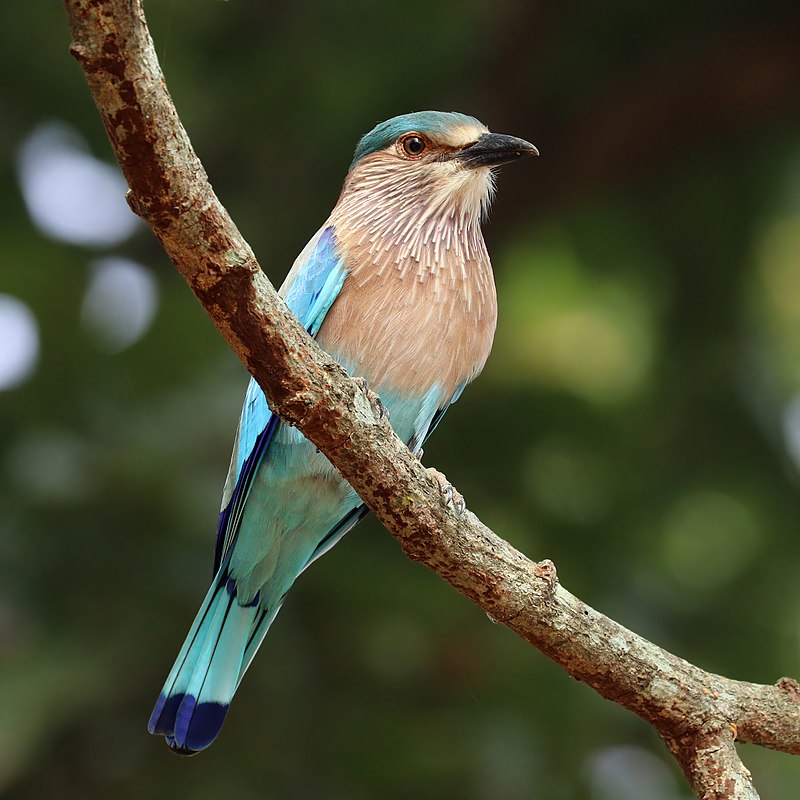
The Indian roller is a beautiful bird of the Coraciidae family. It has an average length of 12-13 inches and weighs 5.9 to 6.2 ounces with a wingspan of 26-29 inches.
Its face and throat are pinkish, while its head and back are brown with blue on its rump, light blue markings on one side of the wing, dark blue markings on other side making it easily distinguishable in flight.
Both male and female have same colouration but males tend to be slightly larger than females though they can only be differentiated when seen together closely due to similar colouring pattern between sexes.
The Indian Roller makes spectacular aerial dives from great heights during courtship display which attracts many viewers each year.
Scientific classification:
| Kingdom | Animalia |
| Phylum | Chordata |
| Class | Aves |
| Order | Coraciiformes |
| Family | Coraciidae |
| Genus | Coracias |
| Species | C. benghalensis |
25. Greater Coucal
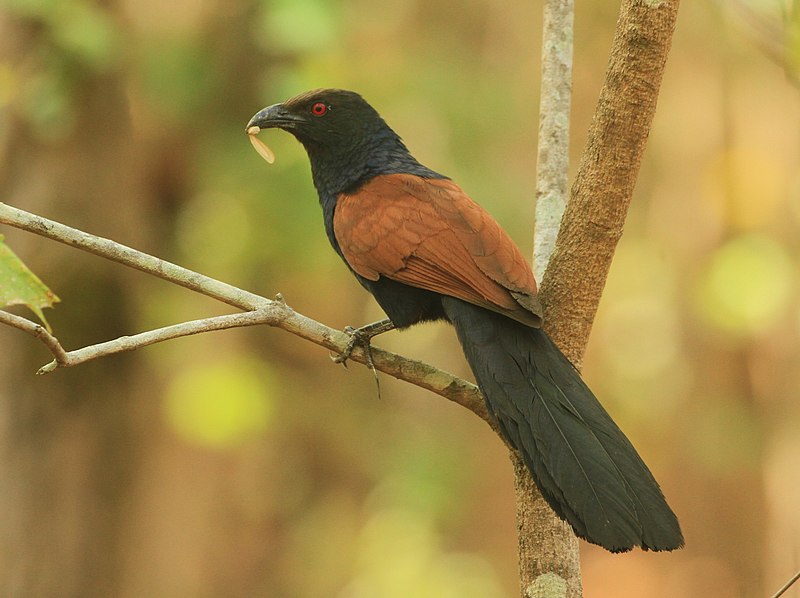
The Greater Coucal is a large, crow-like bird that belongs to the Cuculiformes order. It has a long tail and coppery brown wings.
These birds are found in many habitats across India and Southeast Asia, ranging from jungles to suburban gardens.
They feed on insects as well as small vertebrates such as frogs, lizards or snakes which they capture with their strong beak.
The males have glossy black plumage while females are dark brown above with buff underparts.
During breeding season these birds make loud croaking calls and can often be heard at night when they become active after sundown looking for food sources like termites or grasshoppers between bushes or low branches of trees close by water bodies like rivers, lakes etc.
This species plays an important role in maintaining ecological balance in its habitat by controlling pest populations through predation so it is essential that we protect them from hunting and other threats for future generations to enjoy.
Scientific classification:
| Kingdom | Animalia |
| Phylum | Chordata |
| Class | Aves |
| Order | Cuculiformes |
| Family | Cuculidae |
| Genus | Centropus |
| Species | C. sinensis |
26. Shaheen Falcon
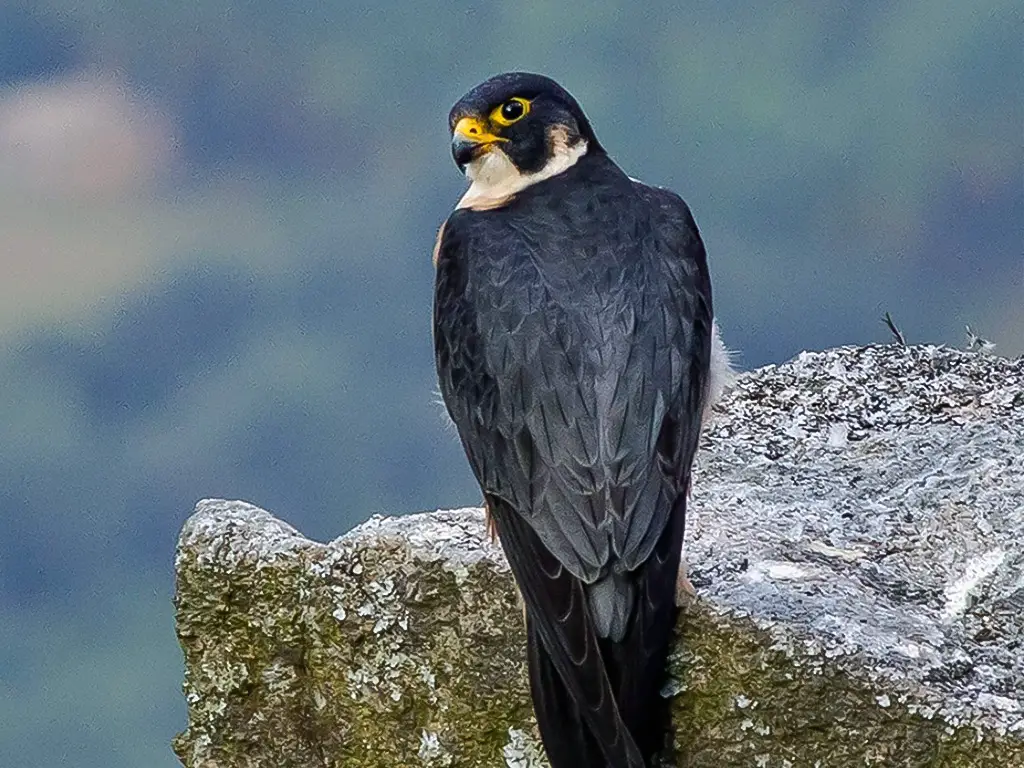
The Shaheen Falcon is a magnificent bird of prey found in the Indian Subcontinent. It has a striking black plumage and white throat, with distinctive slate-grey wings tipped with dark markings.
Its powerful talons make it an efficient hunter, preying on small birds and mammals such as rodents and hares.
The Shaheen Falcon migrates seasonally within its range but some parts of India have been known to hold resident populations all year round.
This subspecies was once called the ‘Indian Peregrine Falcon’ by British officers during colonial times due to their resemblance in appearance to European peregrines.
Today, conservation efforts are underway around India’s protected areas for this species which faces threats from habitat destruction, human disturbance and illegal hunting activities.
Scientific classification:
| Kingdom | Animalia |
| Phylum | Chordata |
| Class | Aves |
| Order | Falconiformes |
| Family | Falconidae |
| Genus | Falco |
| Species | F. peregrinus |
| Subspecies | F. p. peregrinator |
27. Orange Bullfinch
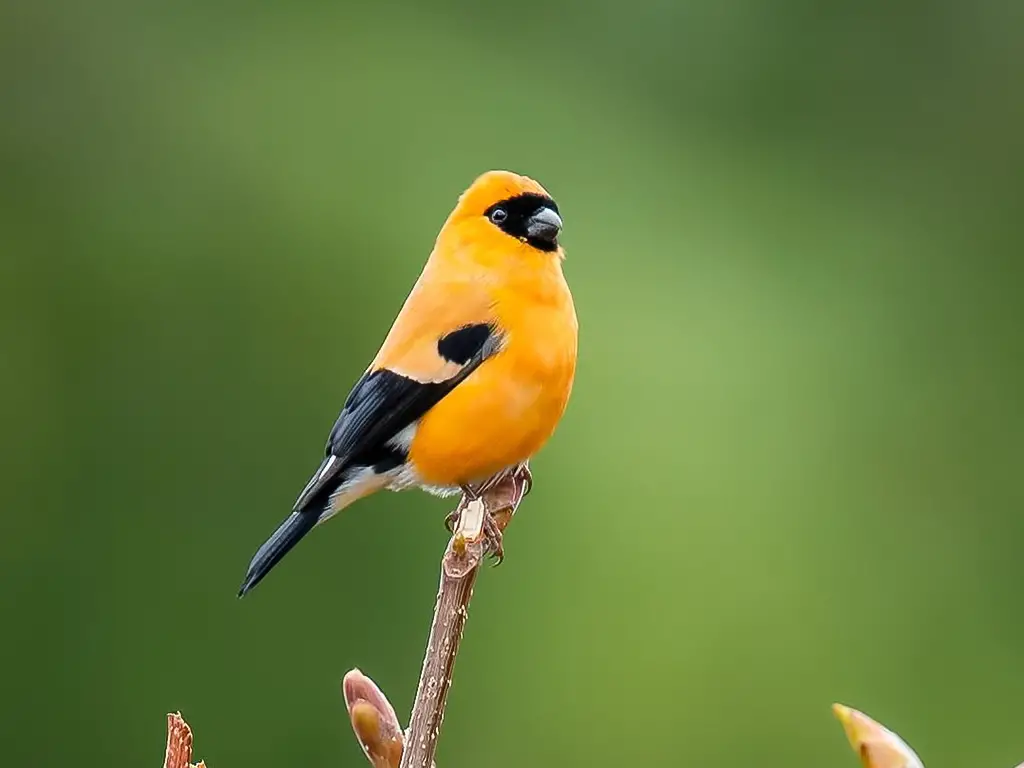
The Orange Bullfinch is a species of finch found in India and Pakistan. It has orange feathers, black wings with white patches, grey backs and yellow heads – making them easily recognizable to bird watchers.
They have been classified as part of the Fringillidae family since 2001 by Arnaiz-Villena et al., who noted that all birds belonging to this genus share a common ancestor: Pinicola enucleator.
The Orange Bullfinch’s natural habitat is temperate forests where they can be seen foraging through trees looking for food such as insects and seeds.
Their diet also includes fruits which adds color to their plumage during the breeding season when males become especially vibrant in order attract potential mates.
Scientific classification:
| Kingdom | Animalia |
| Phylum | Chordata |
| Class | Aves |
| Order | Passeriformes |
| Family | Fringillidae |
| Subfamily | Carduelinae |
| Genus | Pyrrhula |
| Species | P. aurantiaca |
28. Indian Golden Oriole
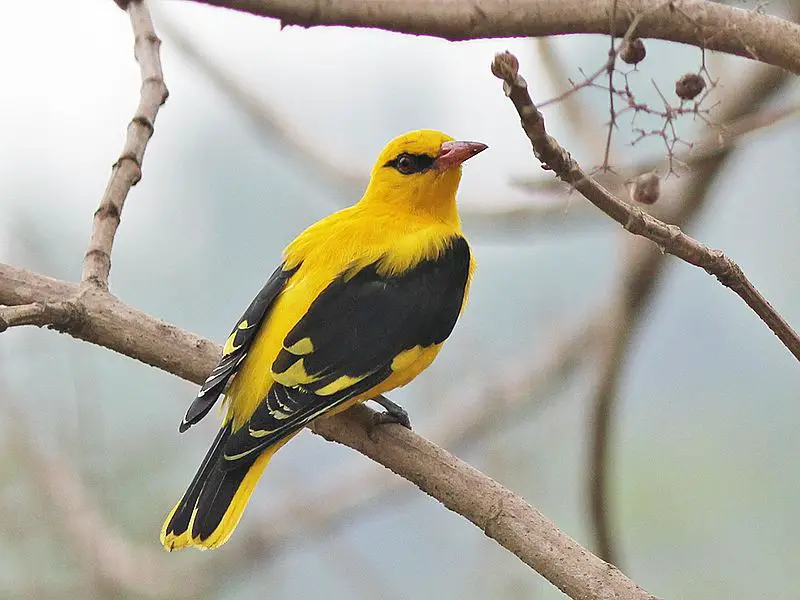
The Indian golden oriole is a species of oriole found in the Indian subcontinent and Central Asia.
It has been identified as a full distinct species from Eurasian golden Oriole by its black eye stripe which extends behind the eyes.
With its bright yellow body, black wings and tail with white patches, this bird stands out among other birds in its region.
The males are more brightly colored than females but both share similar features such as long pointed bills and strong legs for perching or hopping through trees.
They feed mainly on insects, fruits and nectar while their diet may also include small reptiles like lizards depending on availability of food sources around them.
This beautiful songbird can often be spotted during spring when they migrate to find suitable breeding grounds where they build nests high up in tree branches to lay eggs.
Scientific classification:
| Kingdom | Animalia |
| Phylum | Chordata |
| Class | Aves |
| Order | Passeriformes |
| Family | Oriolidae |
| Genus | Oriolus |
| Species | O. kundoo |
Also Featured In: Birds of Andhra Pradesh, Most Common Birds of Bihar
29. Sind Sparrow
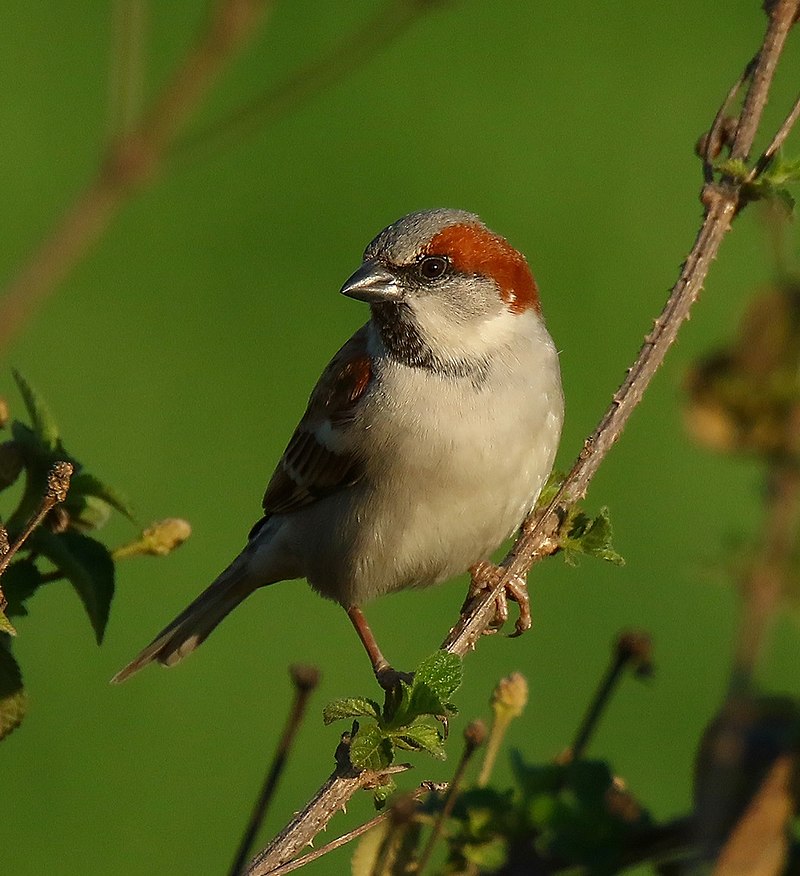
The Sind sparrow is a small passerine bird of the Passeridae family, native to South Asia. It has similar features to the house sparrow but with distinctive plumage differences; males have brighter feathers than females and young birds.
The Sind Sparrow lives in open forests, farmland and rural regions around the Indus Valley region in India, Pakistan and Afghanistan making it an important part of local wildlife.
Its diet consists mainly of vegetation such as grains or seeds along with some insects found on land or water sources like riverside pools.
Conservation efforts are needed for this species due its decreasing population size caused by habitat destruction from human activities such as deforestation and urbanization.
Scientific classification:
| Kingdom | Animalia |
| Phylum | Chordata |
| Class | Aves |
| Order | Passeriformes |
| Family | Passeridae |
| Genus | Passer |
| Species | P. pyrrhonotus |
30. Rose-Ringed Parakeet
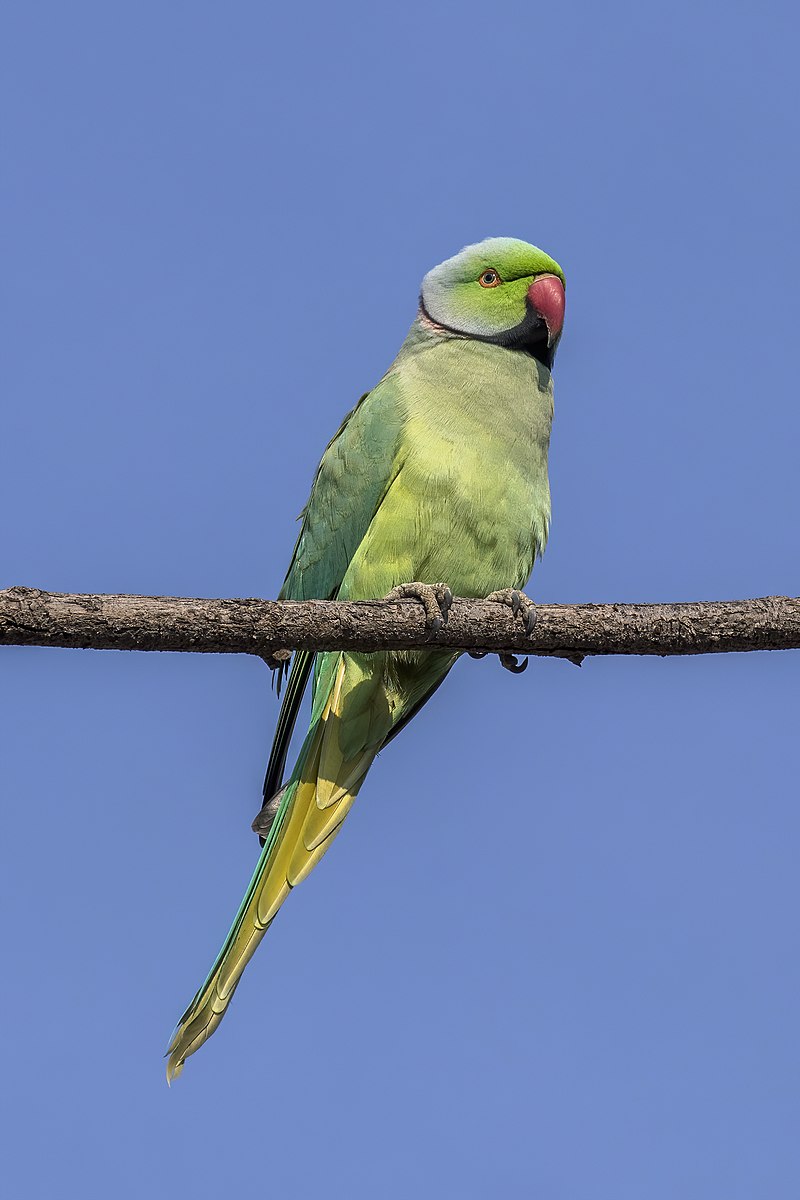
The Rose-ringed parakeet is a medium sized bird in the family Psittacidae. Native to Africa and India, it has been introduced into many other parts of the world where feral populations have now established themselves.
The most distinctive feature of this species is its colorful neck ring ranging from pink to purple which gives them their name.
However, males often display more vibrant colors than females do. This beautiful bird can also imitate human speech quite well making them popular pets worldwide.
In addition they are very social creatures preferring large flocks when out in nature or as part of aviaries during captivity. With proper care these birds can live up to 30 years.
Scientific classification:
| Kingdom | Animalia |
| Phylum | Chordata |
| Class | Aves |
| Order | Psittaciformes |
| Family | Psittaculidae |
| Genus | Psittacula |
| Species | P. krameri |
31. Black-Throated Bushtit
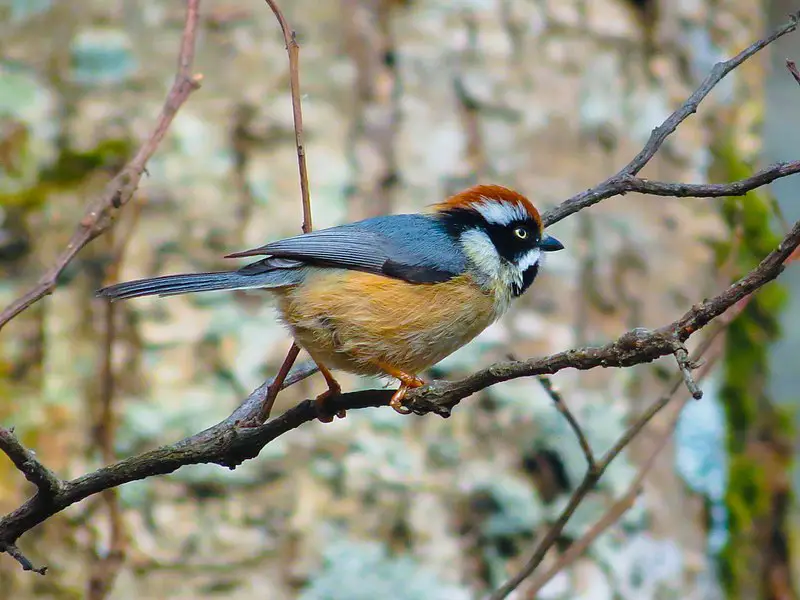
The black-throated bushtit is a small passerine bird found in the family Aegithalidae. It has distinctive markings, with a black throat and pale supercilium on its white head that makes it easy to identify.
Its back, wings and tail are greyish brown while its underparts have yellow tinges. Its size ranges between 10–12 cm long, weighing 6–9 gm as an adult.
These birds inhabit various habitats such as coniferous forests, woodlands and even urban parks where they forage for insects or spiders among foliage or tree bark crevices using their slender bill .
They also feed on fruits like figs when available during winter months especially at higher altitudes across Asia from Afghanistan to eastern China including Pakistan , India , Nepal .
This species often forms large flocks of upto 30 individuals outside breeding season but pairs up during mating period which lasts from February -July depending upon geographic location before migrating southwards towards warmer climates in search of food sources.
Scientific classification:
| Kingdom | Animalia |
| Phylum | Chordata |
| Class | Aves |
| Order | Passeriformes |
| Family | Aegithalidae |
| Genus | Aegithalos |
| Species | A. concinnus |
32. Blunt-Winged Warbler
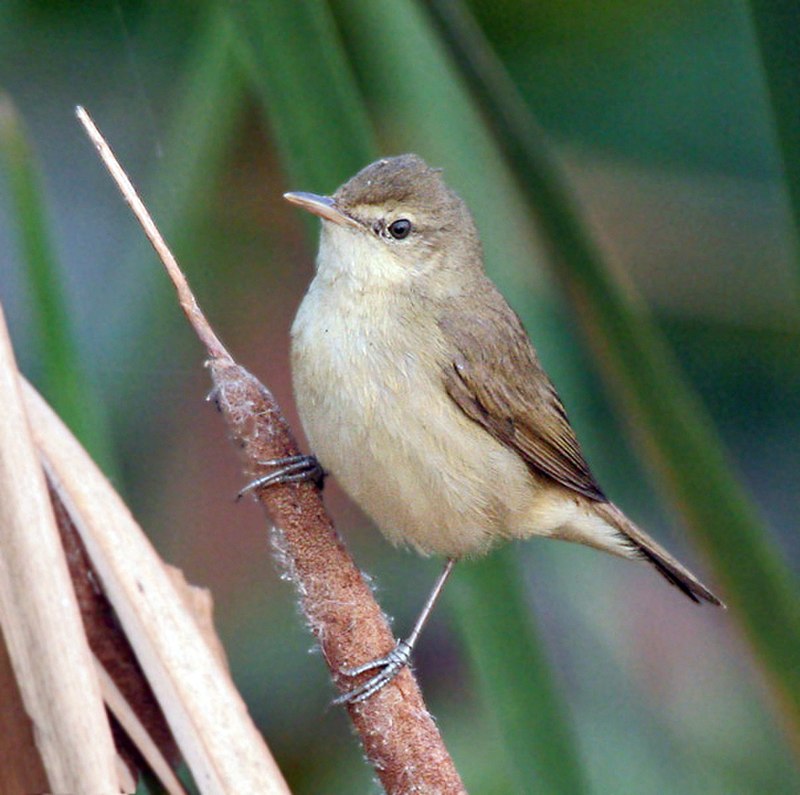
The Blunt-winged Warbler is a marsh-warbler bird species found in several countries of South and Central Asia. It was first described by Robert Swinhoe in 1870, formerly included among the “Old World warblers”.
Its range covers Afghanistan, Pakistan, Northeast India and China while it winters in Myanmar, Thailand and Bangladesh.
This small passerine has olive upperparts with whitish underparts that are heavily streaked dark brown or black on its flanks; its head is greyish with an indistinct pale supercilium above each eye.
The wings have short primary feathers giving them their blunt appearance which gives this species its name; they also feature yellowish fringes to the greater coverts along with white patches on their outer webs near the tips of their tertials.
Scientific classification:
| Kingdom | Animalia |
| Phylum | Chordata |
| Class | Aves |
| Order | Passeriformes |
| Family | Acrocephalidae |
| Genus | Acrocephalus |
| Species | A. concinens |
33. Bay-Backed Shrike
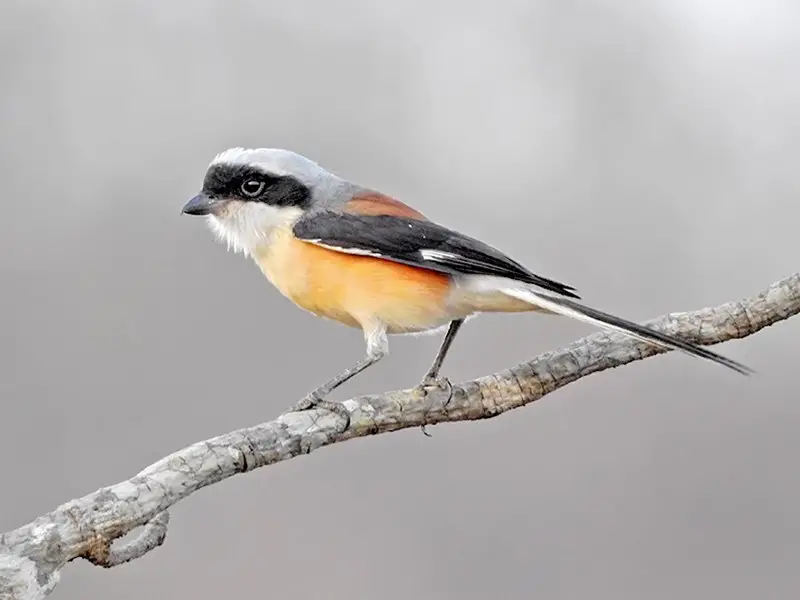
The Bay-backed Shrike is a small, but striking bird native to South Asia. It measures just 17 cm long and has maroon-brown upperparts with a pale rump and a long black tail edged in white.
The underparts are white, while the crown and nape of its neck are grey with a distinctive “bandit mask” of black through the eye area.
Additionally, it has an easily visible white wing patch that contrasts nicely against its otherwise dark plumage.
This species makes for an interesting sight as they search open woodlands or scrubland for their prey including insects, reptiles, amphibians and rodents which they impale on thorns or barbed wire fences like other shrikes.
Scientific classification:
| Kingdom | Animalia |
| Phylum | Chordata |
| Class | Aves |
| Order | Passeriformes |
| Family | Laniidae |
| Genus | Lanius |
| Species | L. vittatus |
34. Bar-Tailed Treecreeper
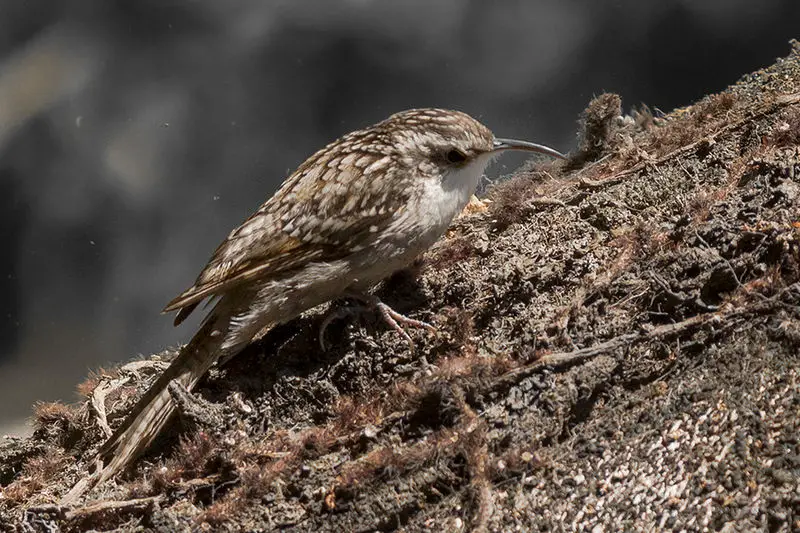
The Bar-tailed Treecreeper is a species of bird found in the northern parts of the Indian subcontinent, including Afghanistan, India, Iran and Nepal.
It has adapted to live mainly in coniferous forests and rocky hillsides at an altitude range from 1000m – 4500m.
Its plumage is generally greyish brown above with white underparts and rufous wings; it also bears a small bill which helps them seek out insects hidden deep within tree bark or cracks.
They are agile climbers who creep up trunks searching for food such as ants and other tiny invertebrates using their long curved claws.
The Himalayan Treecreeper can often be seen clambering around trees during its active hours between dawn till dusk making loud calls that sound like “chick chick”.
Scientific classification:
| Kingdom | Animalia |
| Phylum | Chordata |
| Class | Aves |
| Order | Passeriformes |
| Family | Certhiidae |
| Genus | Certhia |
| Species | C. himalayana |
Also Featured In: Common Uzbekistan Birds,
35. MacQueen’s Bustard
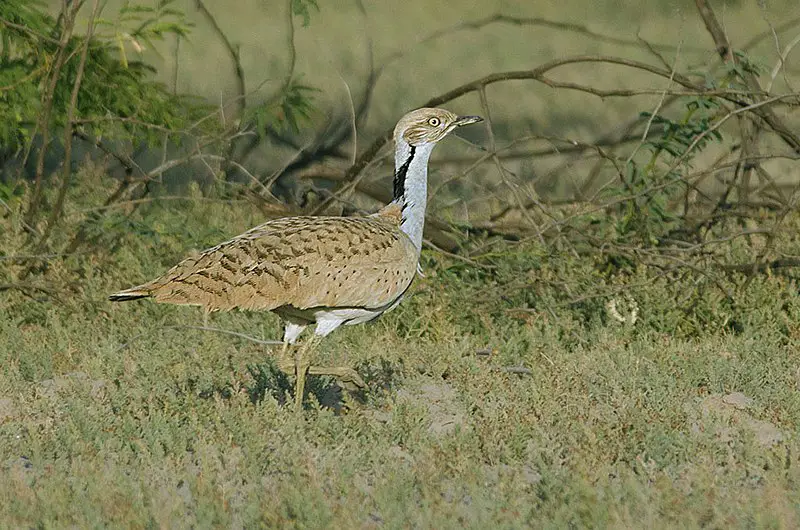
MacQueen’s bustard is a large bird in the bustard family, native to desert and steppe regions of Asia. This species was once seen as far west as Great Britain but has since declined by 20-50% due to hunting and changes in land use.
Its loss has caused concern among conservationists, with some even considering it endangered. It typically lives on dry plains or semi-desert areas where there are low shrubs for cover from predators such as foxes or eagles.
The MacQueen’s Bustard feeds mainly on insects like grasshoppers, spiders and beetles which they find amongst vegetation like shortgrass prairies or agricultural fields.
They also eat small mammals when available during winter months; however this does not make up their primary diet year round.
To protect them from further decline we must work together to reduce hunting pressures and conserve habitat so that these birds can continue living wild into future generations.
Scientific classification:
| Kingdom | Animalia |
| Phylum | Chordata |
| Class | Aves |
| Order | Otidiformes |
| Family | Otididae |
| Genus | Chlamydotis |
| Species | C. macqueenii |
36. Loons
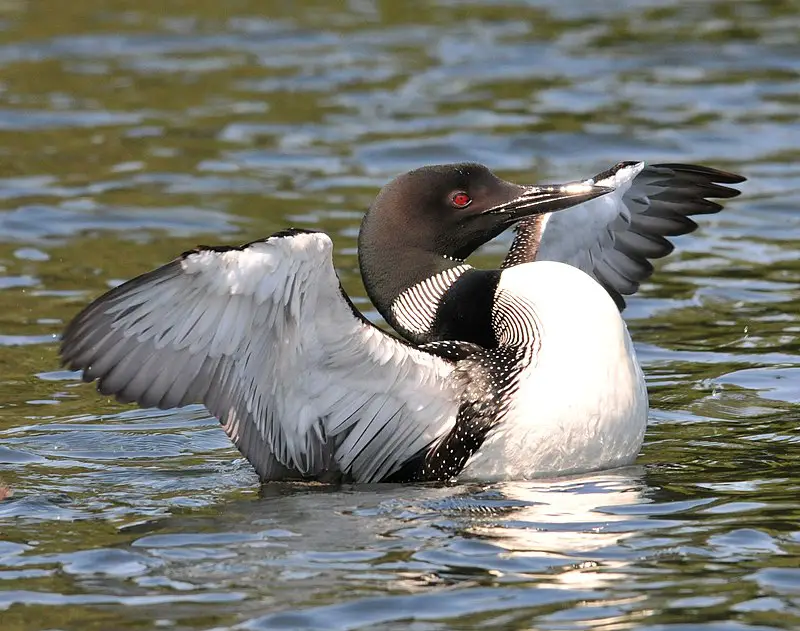
Loons, also known as divers, are aquatic birds belonging to the Gaviiformes order. They inhabit lakes and rivers in North America and northern Eurasia. There are five species of loons that exist today, all within the genus Gavia.
Loons have large webbed feet for swimming underwater and long pointed beaks for catching fish or other animals living in watery habitats.
They can dive up to 200 ft deep when searching for food. In flight they appear graceful with their long neck stretched out straight behind them; however on land they move awkwardly using their wings like flippers to propel themselves forward.
The varied calls made by these majestic creatures has earned them a spot at the top of many bird-watchers’ list.
Scientific classification:
| Kingdom | Animalia |
| Phylum | Chordata |
| Class | Aves |
| Clade | Phaethoquornithes |
| Clade | Aequornithes |
| Order | Gaviiformes Wetmore & Miller, 1926 |
37. Rufous Treepie
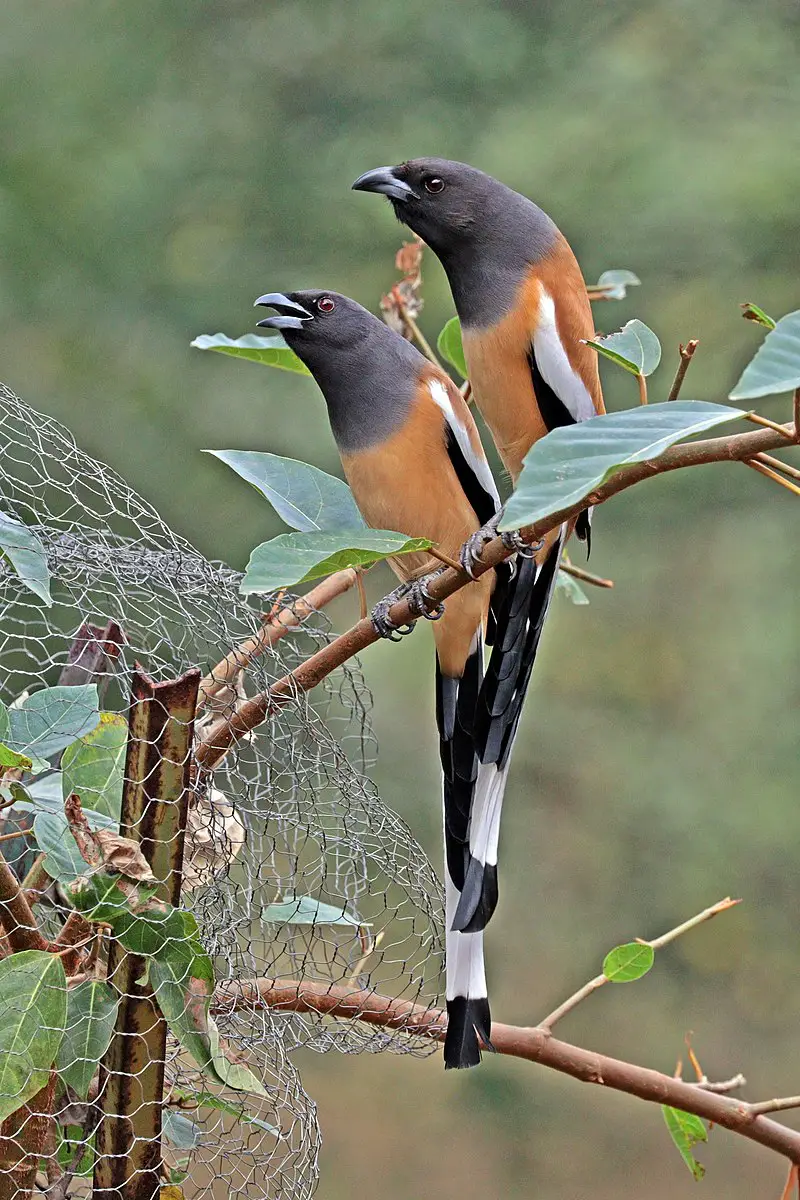
The Rufous Treepie is a member of the Corvidae family and native to the Indian Subcontinent, as well as parts of Southeast Asia. It has distinctive loud musical calls that make it easily recognizable.
This bird can be found in open scrub lands, agricultural areas, forests and even urban gardens due to its adaptability and omnivorous diet.
With its long tail feathers ranging from brown-black to greyish-brown on top with orange underneath; this species stands out among other birds.
They also have an interesting way of eating fruits: they peck at them while hovering midair. The Rufous Treepie is not only beautiful but also quite intelligent – their problem solving abilities are second only to those of primates.
Scientific classification:
| Kingdom | Animalia |
| Phylum | Chordata |
| Class | Aves |
| Order | Passeriformes |
| Family | Corvidae |
| Genus | Dendrocitta |
| Species | D. vagabunda |
Also Featured In: Birds that Live in Tamil Nadu, Birds that Live in Uttar Pradesh
38. Pied Kingfisher
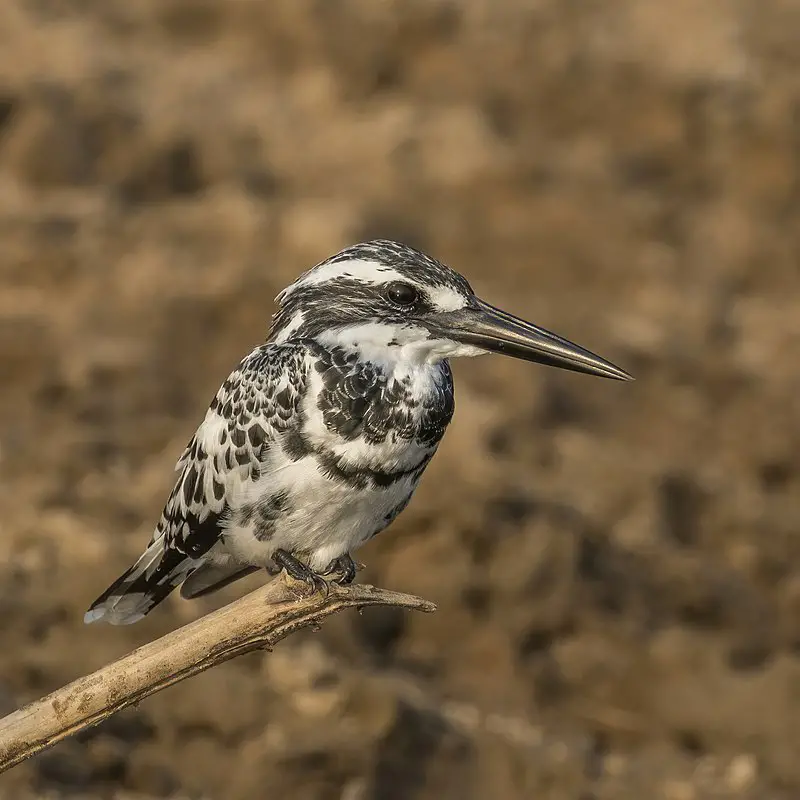
The Pied Kingfisher is a species of water kingfisher found in Africa and Asia. It has black and white plumage, with males sporting a double band across the breast while females have one single band.
This bird makes its presence known by hovering over clear waters before diving for fish – making it easily recognizable.
The diet consists mostly of small aquatic animals such as frogs, crustaceans and insects, but they also consume some plant matter like seeds or fruits occasionally.
The pied kingfisher nests near bodies of water where it can feed off smaller creatures that dwell there; usually in burrows dug into riverbanks or on floating vegetation close to shorelines.
With their distinct colors and behavior patterns these birds make an interesting addition to any wildlife enthusiast’s list.
Scientific classification:
| Kingdom | Animalia |
| Phylum | Chordata |
| Class | Aves |
| Order | Coraciiformes |
| Family | Alcedinidae |
| Subfamily | Cerylinae |
| Genus | Ceryle F. Boie, 1828 |
| Species | C. rudis |
Also Featured In: African Birds, East African Birds
39. Red-Wattled Lapwing
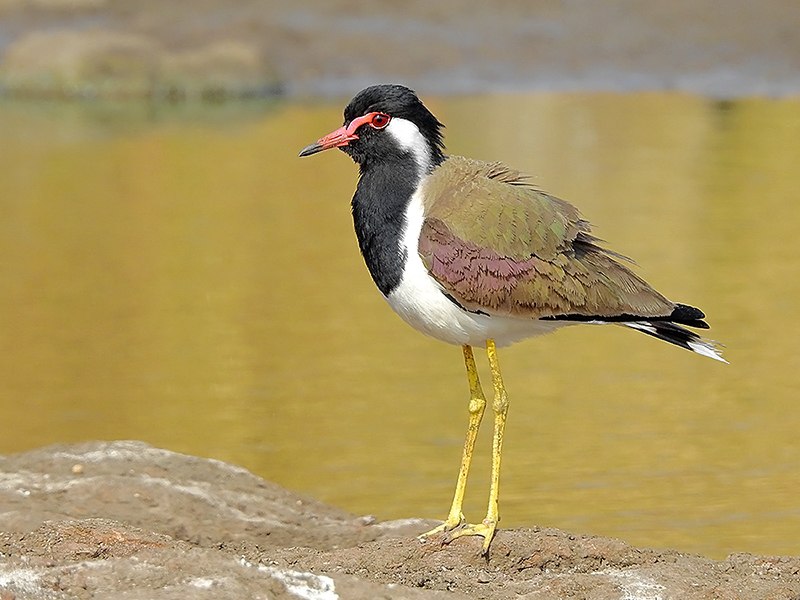
The Red-wattled Lapwing is an Asian bird belonging to the family Charadriidae. It has a distinctive loud call which led to it being nicknamed ‘did he do it’ by locals, due to its sound resembling the phrase.
These birds are usually found on open ground and cannot perch like other lapwings. They have black feathers with white wings, back and tail along with reddish wattles near their eyes that give them their name.
Red-wattled Lapwings feed mainly on insects but also eat some plant matter such as seeds or grains.
During breeding season they form strong pair bonds and make nests in shallow depressions of sand or soil lined with vegetation for incubating eggs during mating season before hatching out young chicks in around 25 days after laying eggs.
Scientific classification:
| Kingdom | Animalia |
| Phylum | Chordata |
| Class | Aves |
| Order | Charadriiformes |
| Family | Charadriidae |
| Genus | Vanellus |
| Species | V. indicus |
40. White-Throated Kingfisher
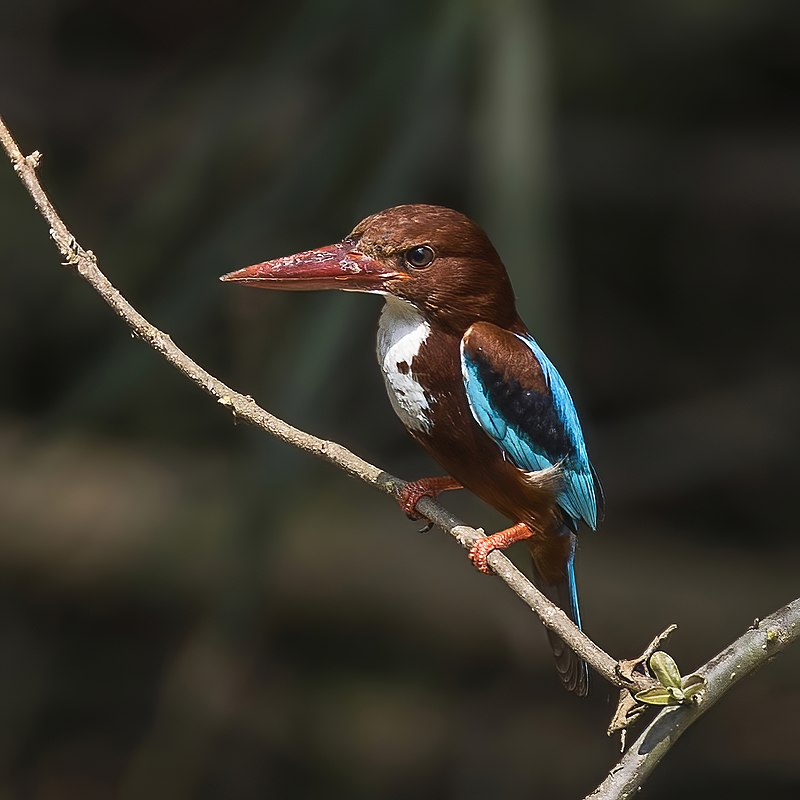
The White-throated Kingfisher is a beautiful bird with bright colors and distinct features. Its back, wings and tail are a deep blue while the head, breast, throat and belly are white.
It has two black stripes across its eyes which contrast nicely against its orange beak and feet.
These birds can often be found perching on tree branches or hovering over creeks in search of food like fish or small insects such as grasshoppers or crickets.
They use their sharp bill to pluck prey from water surfaces then swallow them whole after making adjustments for size by beating it against rocks if necessary.
The White-throated Kingfisher breeds during monsoon season when rainfall increases levels in rivers leading to an abundance of aquatic life that these birds love so much.
Scientific classification:
| Kingdom | Animalia |
| Phylum | Chordata |
| Class | Aves |
| Order | Coraciiformes |
| Family | Alcedinidae |
| Subfamily | Halcyoninae |
| Genus | Halcyon |
| Species | H. smyrnensis |
41. Himalayan Bulbul
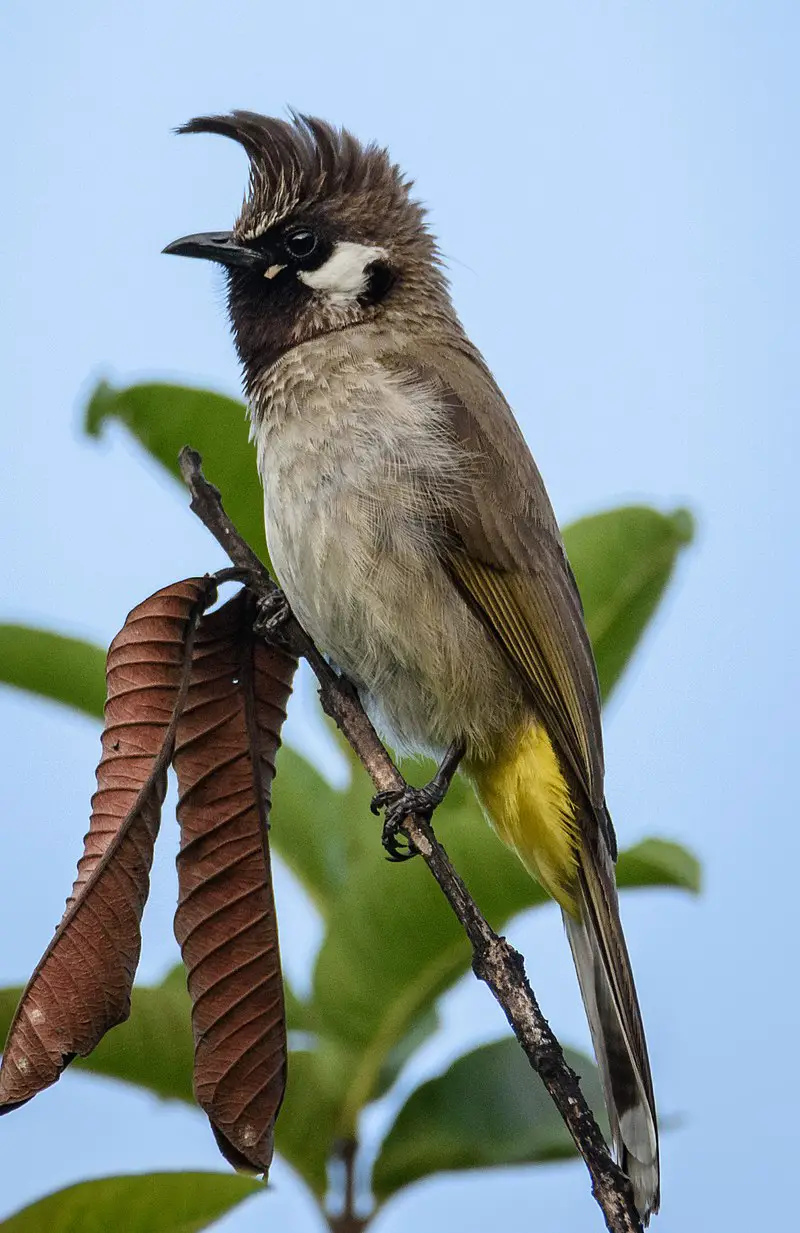
The Himalayan bulbul is a species of songbird found in Central and South Asia, belonging to the same superspecies as other bulbuls such as the white-eared, Cape and common.
It has striking physical characteristics; its head is black with a bronze tint on either side while it’s underparts are greyish-white.
Its most defining feature however, are two bold white cheek patches that contrast against its dark body.
This bird has an impressive vocal range which includes whistles, trills and chirps used for communication between individuals or flocks when they gather together during breeding season.
The Himalayan bulbul mainly eats fruit but sometimes feeds on insects too.
An interesting fact about these birds is their ability to mimic other calls including those made by humans – making them great pets if kept responsibly.
Scientific classification:
| Kingdom | Animalia |
| Phylum | Chordata |
| Class | Aves |
| Order | Passeriformes |
| Family | Pycnonotidae |
| Genus | Pycnonotus |
| Species | P. leucogenys |
42. Yellow-Bellied Prinia
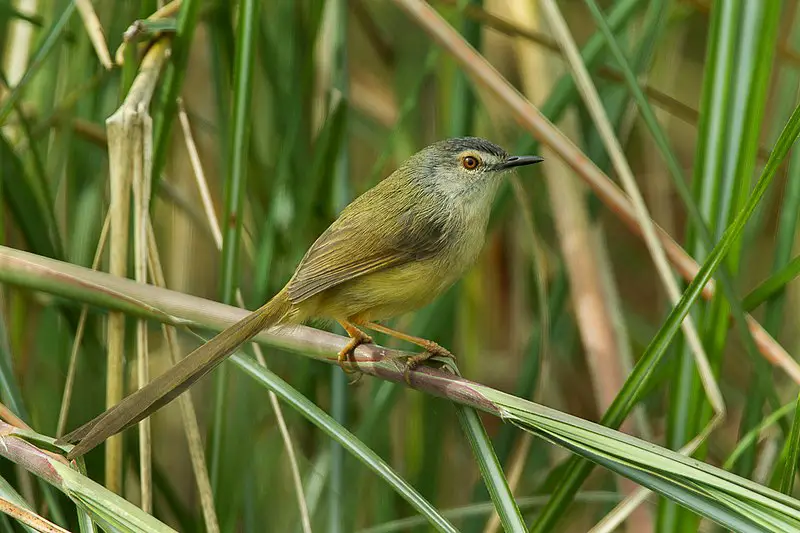
The Yellow-bellied Prinia (Prinia flaviventris) is a species of bird in the family Cisticolidae. It lives mainly in Pakistan, but can also be found along the southern Himalayan foothills and northeastern Indian subcontinent to Southeast Asia.
This small brownish grey bird has a yellow belly with white barring on its wings and tail feathers. Its call is described as being a series of loud chirps or trilling notes which it repeats rapidly for several seconds at a time.
The diet includes flying insects such as moths, beetles, grasshoppers and ants that they catch while hovering over vegetation close to the ground during their search for food.
They are usually seen singly or in pairs near hedges or scrubby areas where there is plenty of cover from predators like snakes and cats.
Scientific classification:
| Kingdom | Animalia |
| Phylum | Chordata |
| Class | Aves |
| Order | Passeriformes |
| Family | Cisticolidae |
| Genus | Prinia |
| Species | P. flaviventris |
43. Common Babbler
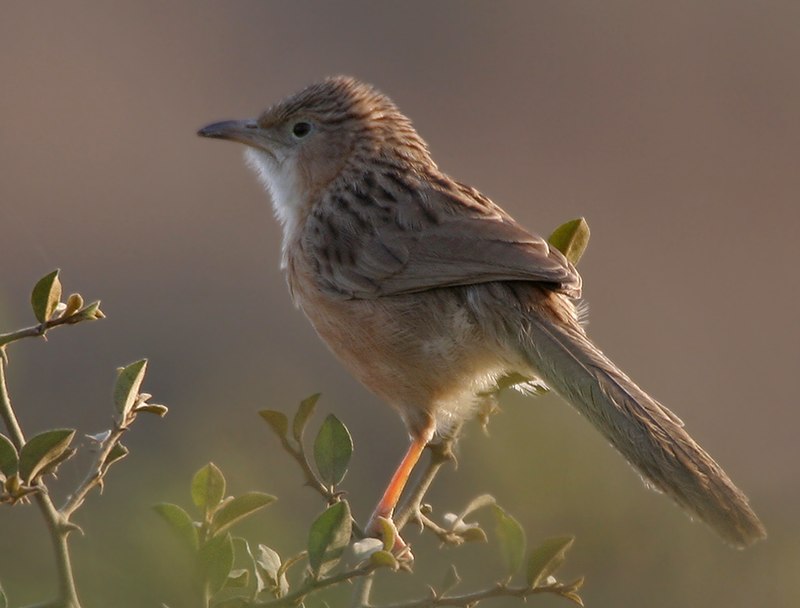
The Common Babbler is a medium-sized, brown bird with an unmistakable long tail. Found mainly in India and parts of Afghanistan, it prefers dry open scrub country near grasslands or cultivation fields.
This unique species has two distinct subspecies; the population to the west of Indus river system are now generally treated as separate species – Afghan Babblers (Turdoides huttoni).
These birds live in pairs or small family groups and can often be seen perched on branches looking for food using their sharp eyesight.
They feed mainly on insects but will sometimes eat berries too.
Despite being relatively common throughout its range this shy creature remains difficult to spot due to its cryptically colored plumage that helps camouflage itself from potential predators.
Scientific classification:
| Kingdom | Animalia |
| Phylum | Chordata |
| Class | Aves |
| Order | Passeriformes |
| Family | Leiothrichidae |
| Genus | Argya |
| Species | A. caudata |
44. Jungle Babbler
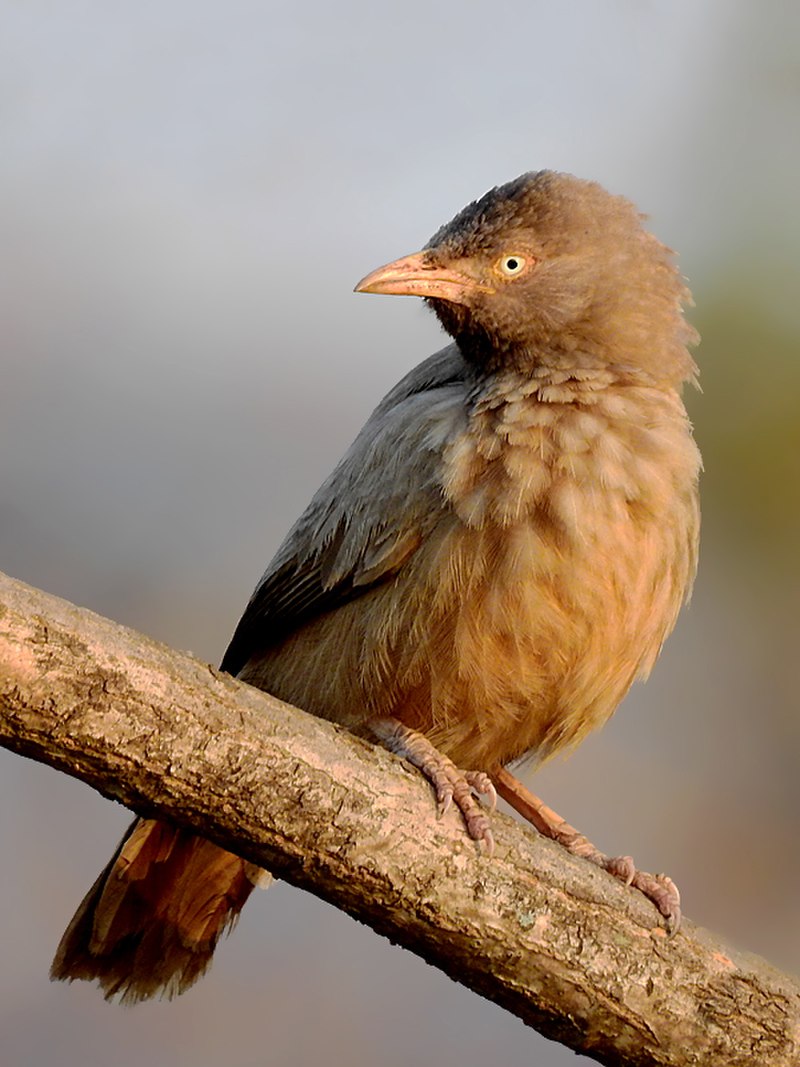
The Jungle Babbler is a member of the Leiothrichidae family, native to India.
It’s known for its gregarious nature and often forms small groups up to 10 birds while they search for food – this habit has earned them the nickname ‘Seven Sisters’ in Northern India, or Saath Bhai (seven brothers) in Bengali.
This colourful bird typically grows around 20 cm long with olive-brown plumage and a black eyestripe running through each eye; it also sports yellowish legs which contrast nicely against their feathers.
The jungle babbler is an omnivore that consumes insects as well as fruits, flowers and nectar from plants.
They are predominantly found near dense forests but may move into shrublands when seasonal changes occur or if there’s a lack of resources available within the forest environment.
With its cheerful call being heard throughout much of Southern Asia, these social birds make great additions to any garden setting.
Scientific classification:
| Kingdom | Animalia |
| Phylum | Chordata |
| Class | Aves |
| Order | Passeriformes |
| Family | Leiothrichidae |
| Genus | Argya |
| Species | A. striata |
Also Featured In: Birds That Live in the Jungle, Birds of Konkan
45. White-Eyed Buzzard
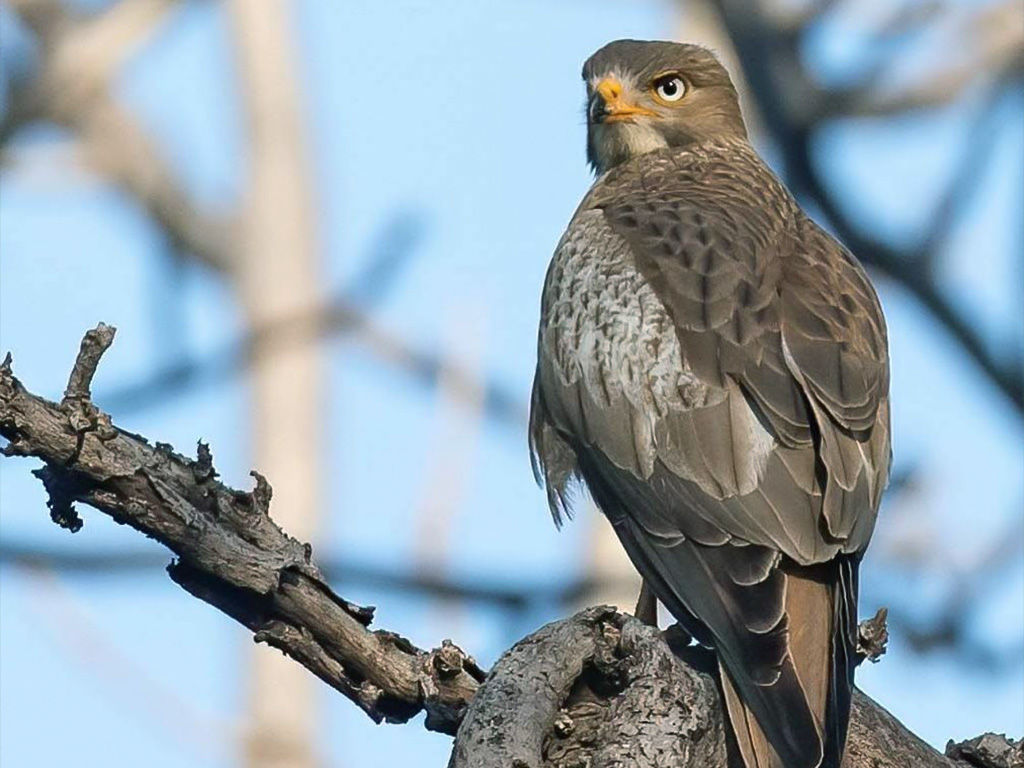
The White-eyed Buzzard is a medium-sized hawk found in South Asia. It has a brown head, rufous tail and distinctive white iris.
Its throat bears a dark mesial stripe bordered by white feathers, while its upper wing holds pale median coverts.
Unlike true buzzards, the underside of their wings don’t have carpal patches.
They feed on small mammals such as rodents and lizards; they also consume snakes and large insects like locusts or grasshoppers.
These birds build stick nests high up in trees for breeding purposes; usually laying one to two eggs at once which are incubated over 4 weeks .
The chicks fledge after about 6 weeks but will stay with their parents until the next breeding season begins when they become independent adults that can live up to 10 years old.
Scientific classification:
| Kingdom | Animalia |
| Phylum | Chordata |
| Class | Aves |
| Order | Accipitriformes |
| Family | Accipitridae |
| Genus | Butastur |
| Species | B. teesa |
Also Featured In: Birds of Goa, Birds You’ll Find in Kanha National Park
46. Cinnamon Bittern
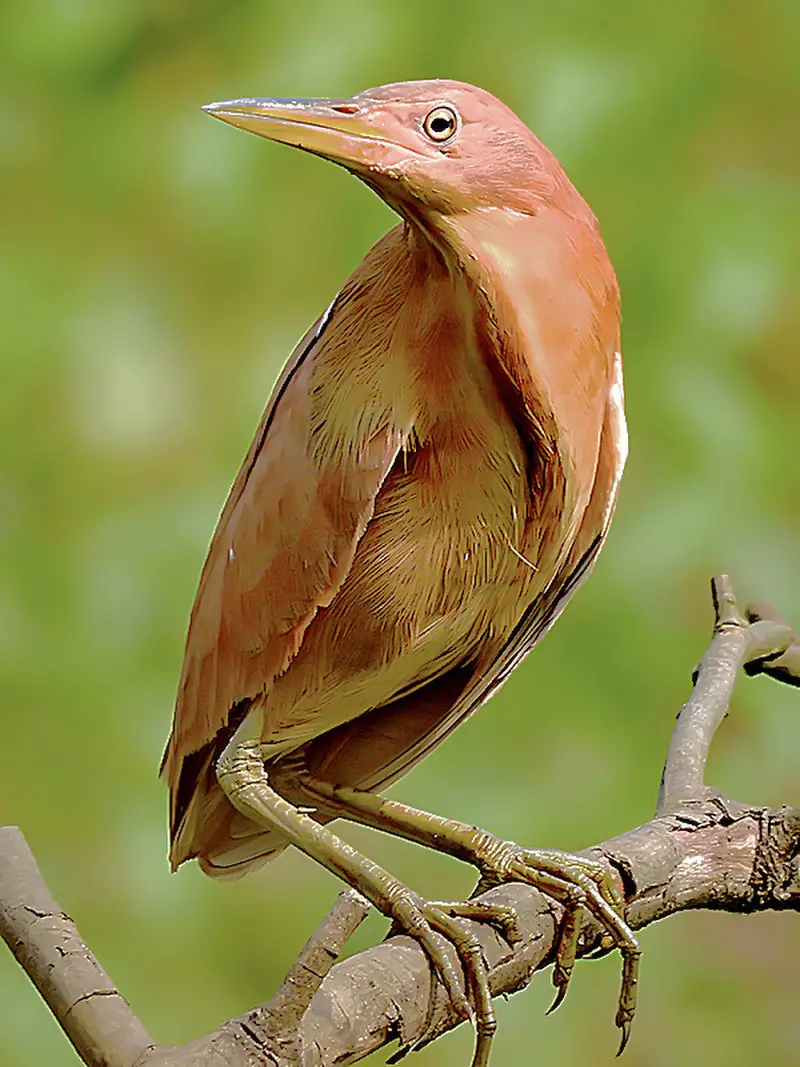
The Cinnamon Bittern is a small Old World bird, found in parts of India, China and Indonesia. It can be identified by its chestnut brown colour on the back and wings with white streaks throughout.
During breeding season it has yellowish-brown plumage on its head neck and breast. Its legs are black which helps distinguish it from other bitterns.
The cinnamon bittern mainly resides in tropical or subtropical climates but some northern birds migrate short distances during winter months for food sources.
They feed mostly on fish, insects, frogs and crustaceans while they breed between April to August making nests near shallow water areas under dense vegetation cover providing safety from predators like snakes or cats that may prey upon them otherwise.
Scientific classification:
| Kingdom | Animalia |
| Phylum | Chordata |
| Class | Aves |
| Order | Pelecaniformes |
| Family | Ardeidae |
| Genus | Ixobrychus |
| Species | I. cinnamomeus |
Also Featured In: Birds that Commonly Found in Bali,
47. Black-Crowned Sparrow-Lark
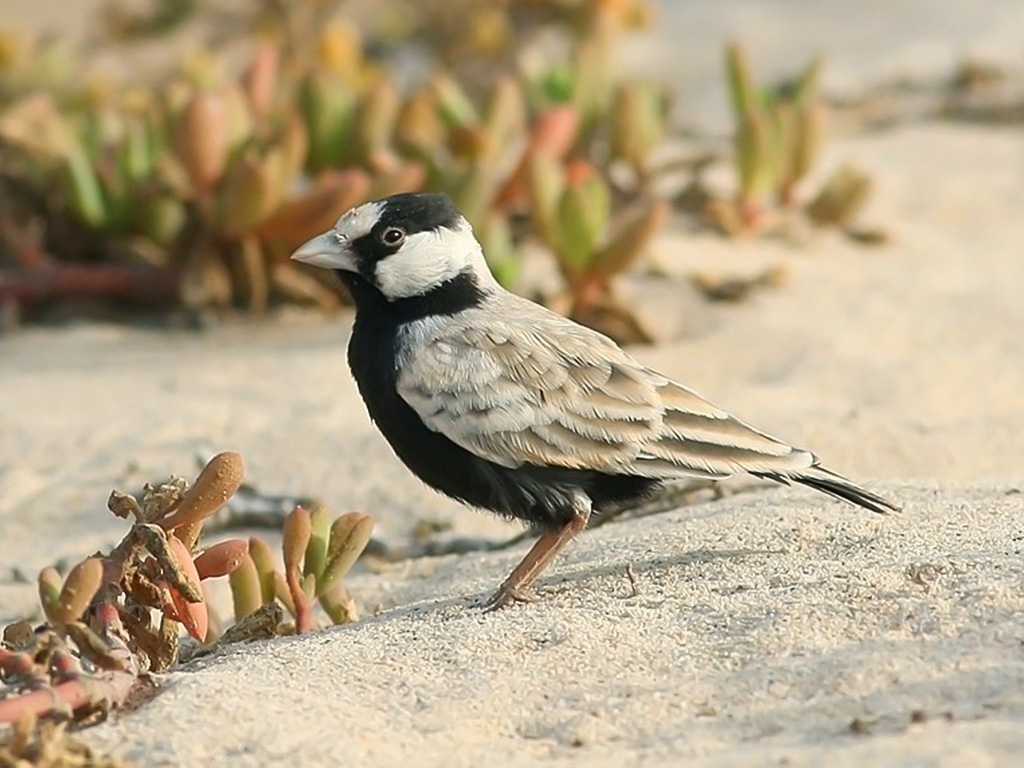
The black-crowned sparrow-lark is a species of lark found in northern Africa, the Middle East and north-western India. It resides in dry savanna habitats where it can be seen foraging for food on the ground.
The bird has an impressive white crest with distinctive black crown feathers that are only visible when viewed from above or behind.
Its brown upper parts mingle with its whitish underparts to provide excellent camouflage against predators, while its long legs allow it to run quickly across open fields if necessary.
Overall, this interesting little bird provides a fascinating sight as it hops around looking for food and flying through the air with grace and agility.
Scientific classification:
| Kingdom | Animalia |
| Phylum | Chordata |
| Class | Aves |
| Order | Passeriformes |
| Family | Alaudidae |
| Genus | Eremopterix |
| Species | E. nigriceps |
Also Featured In: Common United Arab Emirates Small Birds, Common Birds of Socotra
48. Himalayan Rubythroat
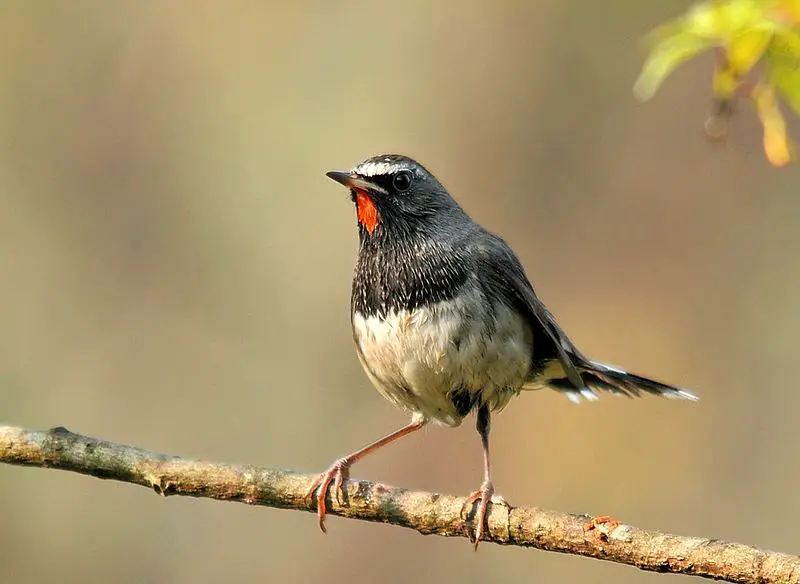
The Himalayan rubythroat is a small passerine bird with bright scarlet plumage and white tail-tips and bases, belonging to the Muscicapidae family. It can be found in the majestic Himalayas stretching from Afghanistan all the way up to India.
This beautiful species was previously grouped together as one along with its relatives – the Chinese rubythroat and Siberian Rubythroat, known as “white-tailed rubythoats”. The distinct features of this unique avian set it apart; making it stand out amongst its kind.
Its little size makes it an endearing sight in any garden or park you visit throughout its range.
Scientific classification:
| Kingdom | Animalia |
| Phylum | Chordata |
| Class | Aves |
| Order | Passeriformes |
| Family | Muscicapidae |
| Genus | Calliope |
| Species | C. pectoralis |
49. Fischer’s Lovebird
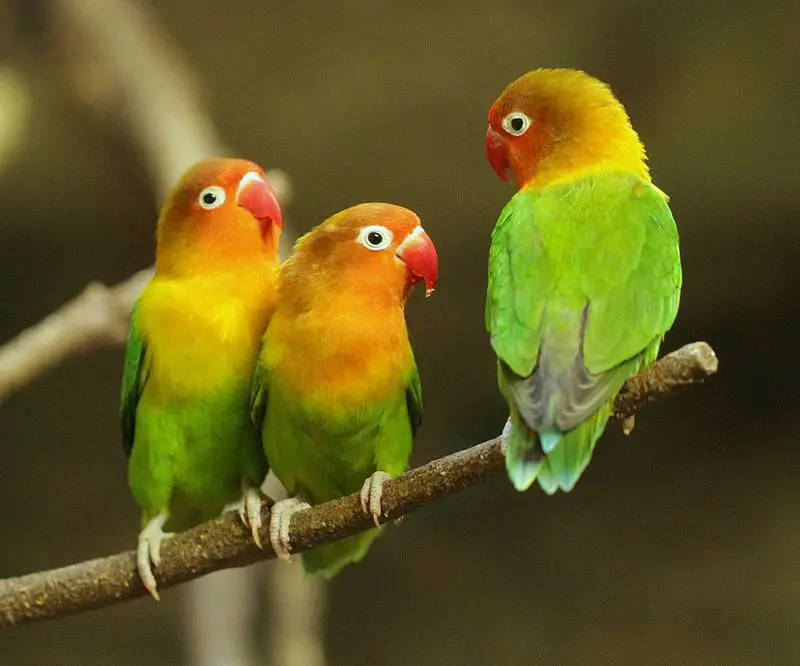
The Fischer’s lovebird is a small parrot species of the genus Agapornis, named after German explorer Gustav Fischer.
They have a beautiful colorful plumage with green backs, chest and wings, and yellow to orange neck coloration that gets darker as it goes up towards the head which is olive-green in color.
Its beak is blackish-grey while its feet are grey or dark brown depending on the subspecies. The most striking feature of this species are their eyes which range from deep red to light pinkish-red in colour.
These birds make wonderful pets due to their playful nature and intelligence; they can even learn simple tricks like vocalizing words or phrases.
Overall, these little birds provide plenty of entertainment and companionship for those who own them – making them an ideal choice for anyone looking for a pet bird companion.
Scientific classification:
| Kingdom | Animalia |
| Phylum | Chordata |
| Class | Aves |
| Order | Psittaciformes |
| Family | Psittaculidae |
| Genus | Agapornis |
| Species | A. fischeri |